Another Bouncing Ball: August 2010 Archives
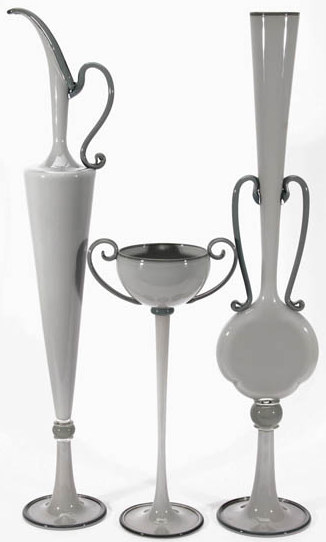
 Son of glass artist Paul Marioni, Dante grew up with glass, taking his first rod out of the furnace at age 10 and saturating himself in his teens in the practice, history and aesthetic possibilities of the medium.
By high school, he was a pro and saw no need to interrupt his career with college.
Raised among those who prized art over craft, he found his identity in the craft camp. What moved him was skill and polish. Growing up in Seattle in the 1970s, he was in a good position to acquire both.
Son of glass artist Paul Marioni, Dante grew up with glass, taking his first rod out of the furnace at age 10 and saturating himself in his teens in the practice, history and aesthetic possibilities of the medium.
By high school, he was a pro and saw no need to interrupt his career with college.
Raised among those who prized art over craft, he found his identity in the craft camp. What moved him was skill and polish. Growing up in Seattle in the 1970s, he was in a good position to acquire both.
In 1971, Dale Chihuly helped found Pilchuck Glass School and hired Venetian master craftsmen to teach there. Following the lead of Venetians such as Lino Tagliapietra and Venice-trained Americans such as Ben Moore and Richard Marquis, Marioni became so skilled that he was in demand on top glass-blowing teams while still in high school. In 1987, at age 23, he had his first solo show at the William Traver Gallery and sold it out. (Those were the days.)
In spite of his insistence that he's a craftsman first and foremost, there was never been any doubt that he's an artist. The objects he makes are a response to the world in which he lives. They are his blend of ancient pottery, Art Deco, comics and above all a Pop sensibility, fused and purified by his natural inclination toward the crisp, witty and lean.
His straight-shot tones are cunningly uncomplicated, both direct and silky. His mosaic patterns have an airy, smoky quality. The colors that define them look as if electric currents left them burnt and fragile at their roots.
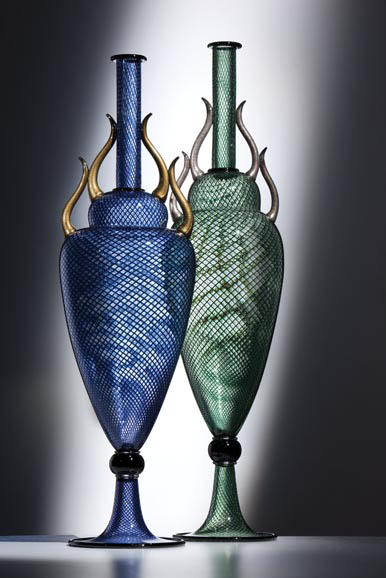 Every year, working within a well-defined vocabulary, he gets better and better. Sunday is the last day for his latest at Traver Gallery.
Every year, working within a well-defined vocabulary, he gets better and better. Sunday is the last day for his latest at Traver Gallery. Eric Yahnker isn't in it but could have been. The freak note would have been welcome.
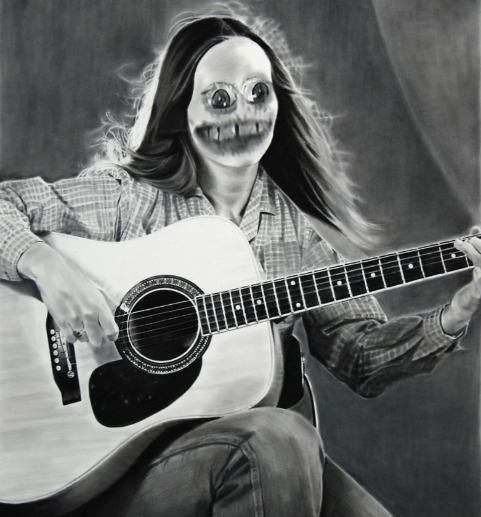 This too. Nothing like a Jackson Family-Cobain mash up.
This too. Nothing like a Jackson Family-Cobain mash up.Kurt could have featured YouTube tributes in a corrdior, any corridor. My personal favorite, also, of course, not in the show, is from the Ukulele Orchestra of Great Britain. Smells Like Teen Spirit traveled many miles to get there.
Wanting more doesn't suggest a lack of respect for curator Michael Darling's excellent product. I love this show. My review in Modern Painters. Last in, Ben Davis on ArtNet here. Davis does a fine job. Only one paragraph stopped me:
Inasmuch as there is another possibility for relating to pop culture in this show, it comes in the form of Charles Peterson's black-and-white images of the early Nirvana onstage. Yet as stirring as these pics are, they feel like documentary, not art.Ben: The is-documentary-photography-art question was resolved before you were born. Anyone who can look at Peterson's version of Nirvana and question whether it's art has a hole-in-soul. There's death all over it, death and love.
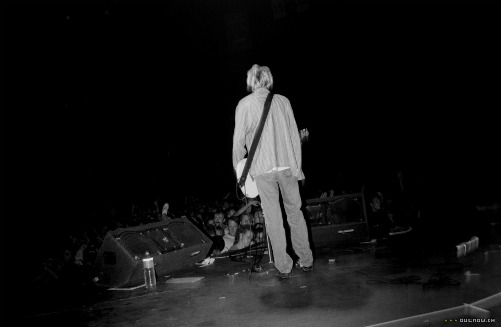 Davis is right on about Alice Wheeler, however.
Davis is right on about Alice Wheeler, however.However, at least one piece at SAM does offer the sought-after spark of connection with Kurt Cobain, in spirit as well as in subject matter: Northwest photographer Alice Wheeler's image of a young man, with bleached, Cobain-esque hair, and the whisper of a beard, staring out at us with an indecipherable intensity. He wears a Nirvana T-shirt, beneath a red-checked lumberjack shirt. The old Seattle Kingdome sits in the background (long since demolished to make way for not one, but two wasteful replacement stadiums, with corporate names), time-stamping the picture. He stands in front of one of Seattle's tent cities for the homeless, which, you guess, he calls home. People used to knock grunge as "homeless chic." Here things flow the other way.
Tent City, Seattle, WA, April, 1999, as the piece is called, touches on the relationship of art, celebrity and the real world, like all the other art here, but the stakes are vivid and clear. Wheeler's photo hurts a little to look at, because you have the sense of something frail and confused and human looking back at you. But let's be honest: Only something that hurts a little can be true to the past that this show tries to tap into, or, for that matter, to our present.
 Like the quilters from Gee's Bend, Marita Dingus uses what she has, in her case, rags, pop tops, pull tabs, computer innards, film negatives,
bottles, shells, stones, eye glass lenses, yarn, telephone wire, crime
scene tape, drains, battered baking tins, light-bulb sockets, paper clips, plastic flowers, paint brushes, bits of wire, bent silverware, pacifiers, colored tape, paint and coarse thread.
Like the quilters from Gee's Bend, Marita Dingus uses what she has, in her case, rags, pop tops, pull tabs, computer innards, film negatives,
bottles, shells, stones, eye glass lenses, yarn, telephone wire, crime
scene tape, drains, battered baking tins, light-bulb sockets, paper clips, plastic flowers, paint brushes, bits of wire, bent silverware, pacifiers, colored tape, paint and coarse thread.
And glass. Her glass heads (thick, flat and transparent) and bodies (pearish) were created in the hot shop at the Museum of Glass under her direction. Her work has a burrowing mole feeling, as if she's digging ever deeper into the earth. Glass gives her burrowing intensity a point of light, a contrast that functions as an intensifier. She paints features on them and embeds in each aspects of a different personality.
Currently at the Francine Seders Gallery are a series of her baskets and babies, both haunted by the idea of family.
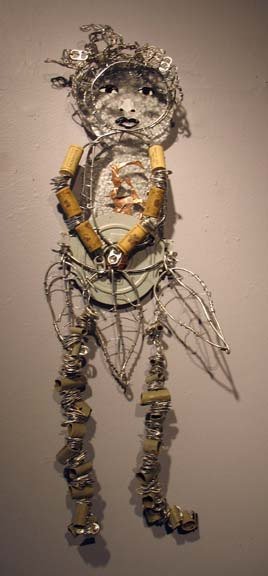
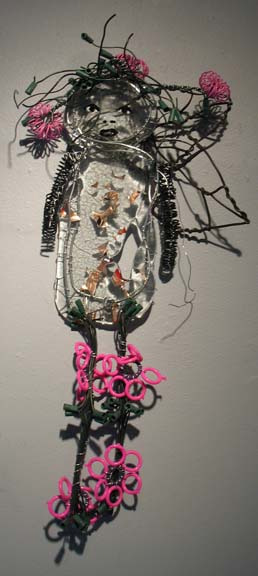 Another family-obsessed Seattle artist, Richard Hugo, took Theodore Roethke's poetry class at the University of Washington in the late 1940s and puzzled over a final exam question, "What should the modern poet do about his ancestors?"
According to Straw for the Fire: Notebooks of Theodore Roethke, 1943-63, (edited by David Wagoner, 1972), Hugo raised his hand. "Do you mean his blood ancestors or the poets who preceded him?"
Roethke gave nothing away. "Just answer the question," he said.
Hugo, like Dingus, turned the answer into a life's work.
Another family-obsessed Seattle artist, Richard Hugo, took Theodore Roethke's poetry class at the University of Washington in the late 1940s and puzzled over a final exam question, "What should the modern poet do about his ancestors?"
According to Straw for the Fire: Notebooks of Theodore Roethke, 1943-63, (edited by David Wagoner, 1972), Hugo raised his hand. "Do you mean his blood ancestors or the poets who preceded him?"
Roethke gave nothing away. "Just answer the question," he said.
Hugo, like Dingus, turned the answer into a life's work.For Dingus, the ancestral pull is the African diaspora, the trauma of slavery and its cultural reverberations. From her mother and grandmother, she learned to use a sewing machine as someone else might use a pencil, to articulate form and inflect it with personality. Her baskets are a kind of quilt you can hold in your arms.They evoke the rough grace of a garden with its dirt and worms and catch the visual pulse of an erratic pattern.
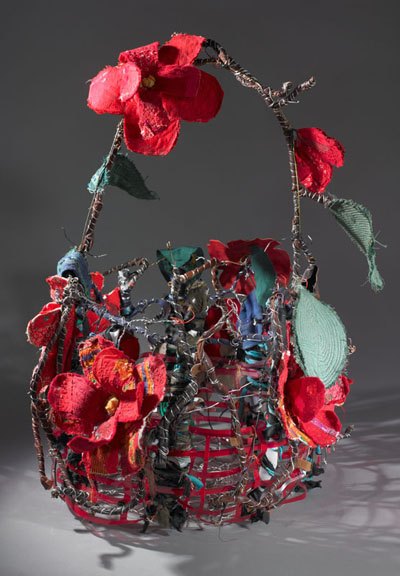 Ragged grace is her signature. What she can pick up for free she cuts, sews, paints and tapes into her sculptures.
Ragged grace is her signature. What she can pick up for free she cuts, sews, paints and tapes into her sculptures.In everything she does, there is always the wound and the struggle to survive it. What Roethke wrote about cut flowers applies to her work:
This urge, wrestle, resurrection of dry sticks,
Cut stems struggling to put down feet,
What saint strained so much,
Rose on such lopped limbs to new life?
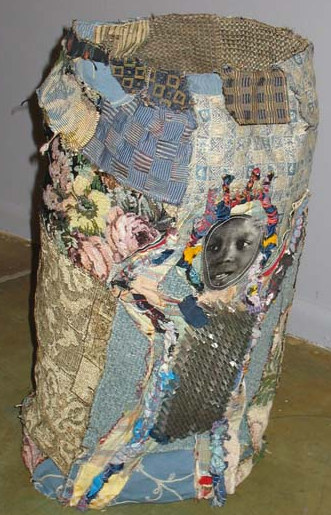 Through Sept. 5.
Through Sept. 5.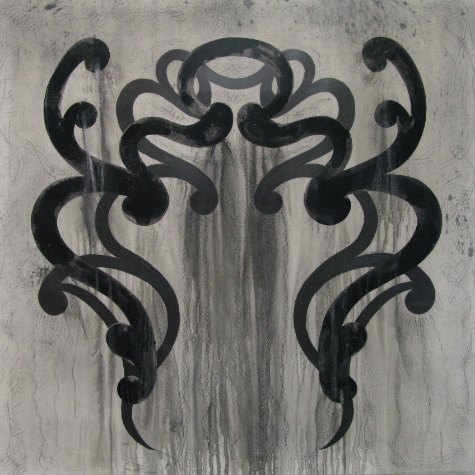 Alonso was born in Havana in 1956, three years before Fidel Castro came to power. Alonso remembers food being scarce and people being taken away at night for speaking with less than revolutionary fervor. When he was six, his mother died, and when he was 9, his father sent him to Miami to live with relatives.
Alonso was born in Havana in 1956, three years before Fidel Castro came to power. Alonso remembers food being scarce and people being taken away at night for speaking with less than revolutionary fervor. When he was six, his mother died, and when he was 9, his father sent him to Miami to live with relatives. His career charts a quiet persistence, an insistence that he will one day produce something of consequence. He was 40 before he found his mature style, a breakthrough that Jacob Lawrence might have been the first to notice. In 1997, when ARTnews asked Lawrence to recommend a young artist who was worthy of greater attention, he wrote back:
The person who comes to mind is Juan Alonso, a Cuban-born painter. His work is deeply personal, autobiographical, figurative but not illustrative, and it could only be produced by someone from the Caribbean.Alonso works in layers of matte and shine in ink, graphite and varnish, building a structure that gives the moist atmospherics around it a ground to engage.
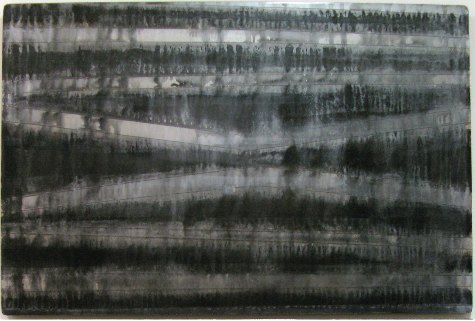 Snakes and chevrons, horizon lines repeatedly breaking over a mountain: These things he suspends in the cloudy mixtures of memory.
Snakes and chevrons, horizon lines repeatedly breaking over a mountain: These things he suspends in the cloudy mixtures of memory. Alonso has not yet returned to Cuba, and is ambivalent about friends to visit and come home full of praise.
Alonso:
I don't think they realize that Cubans working in the tourist hotels are not allowed to eat there or even talk freely to the customers. I have a nephew in that position. It's real. But Americans visit and say the place is lovely. I say, yes, my island is lovely. It's a lovely police state.At Francine Seders through Sept. 5.
1. Held her breath.
Adriana Zarate
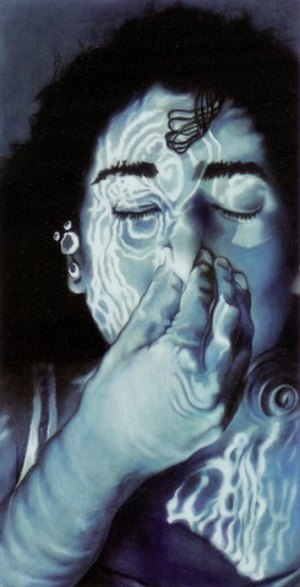 2. Shed her heavy clothes and swum to shore.
2. Shed her heavy clothes and swum to shore.Alan Graham Dick
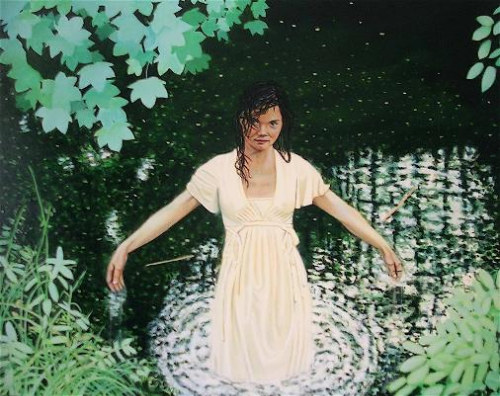 3. Kept her clothes on, relying on youth and excellent muscle tone to pull through.
3. Kept her clothes on, relying on youth and excellent muscle tone to pull through.Ryan Jeffery
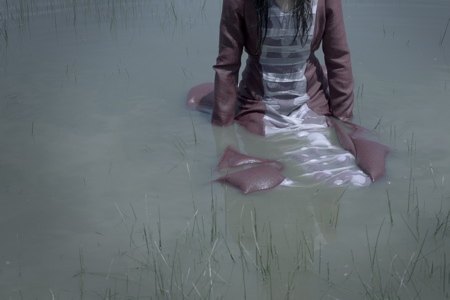 4. Let her grievances keep her afloat.
4. Let her grievances keep her afloat.Eric Fortune
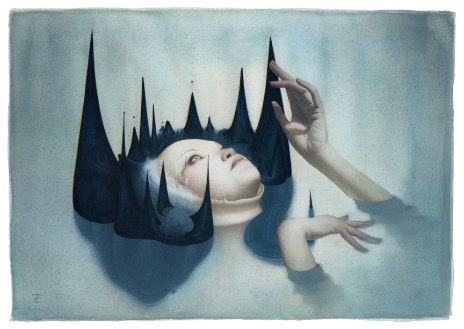 5. Sought Revenge
5. Sought RevengeMartina Randles
 6. Remembered that, as Tom Robbins likes to say, it's never too late to have a happy childhood.
6. Remembered that, as Tom Robbins likes to say, it's never too late to have a happy childhood. Lina Raymond
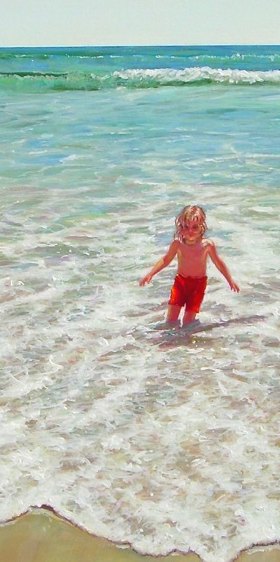
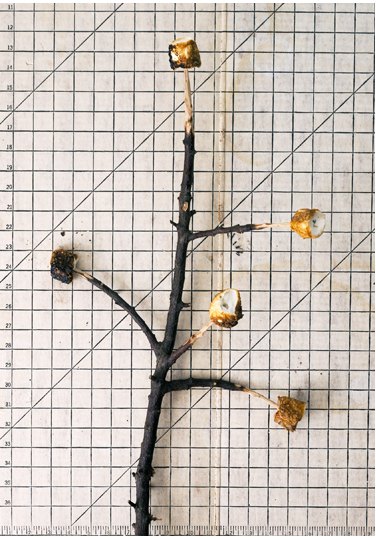
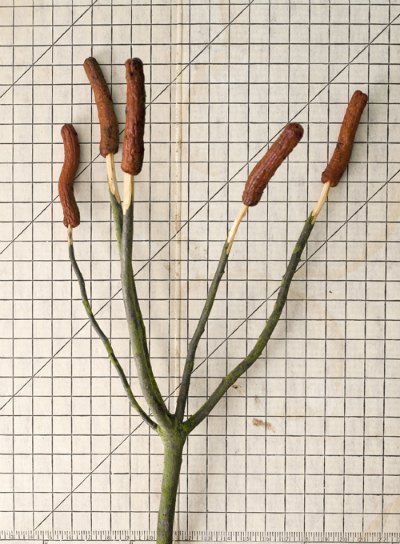 The process is the product: both forlorn and fugitive, like shoveled smoke.
The process is the product: both forlorn and fugitive, like shoveled smoke.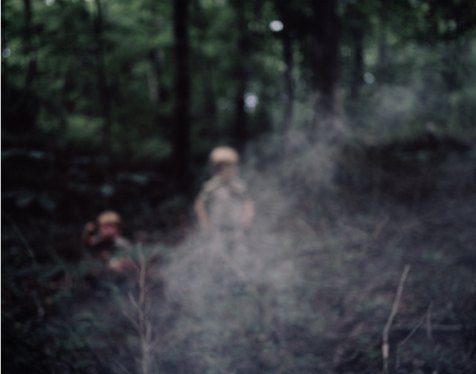 At Vermillion through Sept. 4.
At Vermillion through Sept. 4.Molly Norris, Self-Portrait, 1982
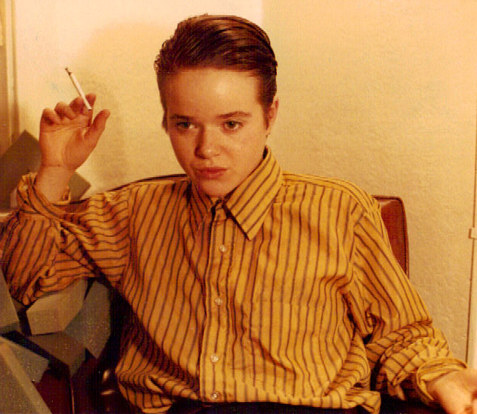 A character in Sarah Schulman's 1988 mystery novel, After Delores, felt confident she had cracked the code.
A character in Sarah Schulman's 1988 mystery novel, After Delores, felt confident she had cracked the code.Where are we going?As a straight woman, I hope it isn't true, but I fear it's a more reliable guide than slicked-back short hair and a man's shirt.
Charlotte's place. I have the key.
How did you know it was okay to come out to me so quickly? I asked.
Easy. Charlotte taught me the trick. She says that if you're talking to a woman and she looks you in the eye and really sees you and listens to what you have to say, then you know she's gay.
What Do-Ho Suh floats, Yamamoto makes as heavy as a tomb.
Currently at Greg Kucera: GRANDFATHER'S SHED, 2008-10 Lāna'i City, Island of Lāna'i Digitally carved and hand finished marble
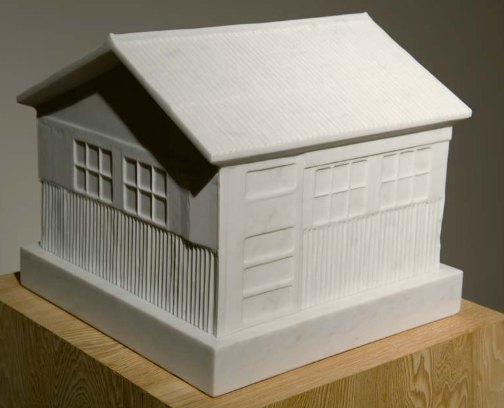 Hawaii is a symbol of an easy life, with fish crowding the seas and fruits ripe for the plucking, and yet, following World War II, canned goods became a staple, particularly (and inexplicably) Spam. Yamamoto's rendering in vitreous china gives the cans the purity of Communion wafers.
Hawaii is a symbol of an easy life, with fish crowding the seas and fruits ripe for the plucking, and yet, following World War II, canned goods became a staple, particularly (and inexplicably) Spam. Yamamoto's rendering in vitreous china gives the cans the purity of Communion wafers.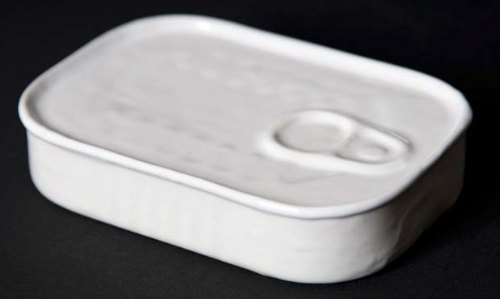 PROVISIONS, POST-WAR, Pacific Asia and U.S. (Spam), 2007-10
Vitreous china
PROVISIONS, POST-WAR, Pacific Asia and U.S. (Spam), 2007-10
Vitreous china
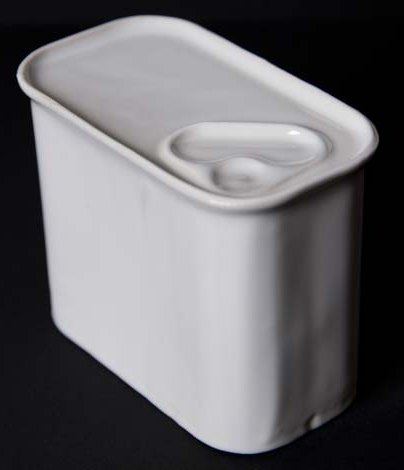 Just as human immigrants came to the island in waves, displacing the first peoples, insects immigrated with them, pushing the original occupants out of their niches. Yamamoto's work is so beautifully crafted and physically recessive, it hides as much as it reveals. The exception is her embroidery on found doilies, which she displays from the back side, with black knots providing the relish of a coarse vitality: Dollies undone.
Just as human immigrants came to the island in waves, displacing the first peoples, insects immigrated with them, pushing the original occupants out of their niches. Yamamoto's work is so beautifully crafted and physically recessive, it hides as much as it reveals. The exception is her embroidery on found doilies, which she displays from the back side, with black knots providing the relish of a coarse vitality: Dollies undone.INSECT IMMIGRANTS, AFTER ZIMMERMAN (1948), 2009-10 Embroidery on found doilies
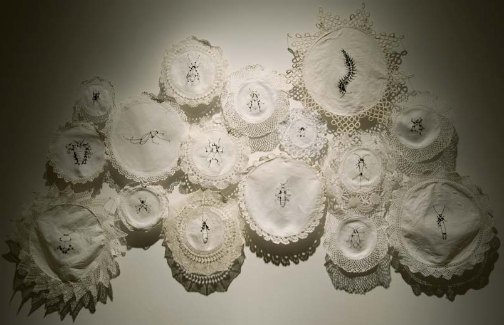 Camamponotus maculates (carpenter ant)
Camamponotus maculates (carpenter ant)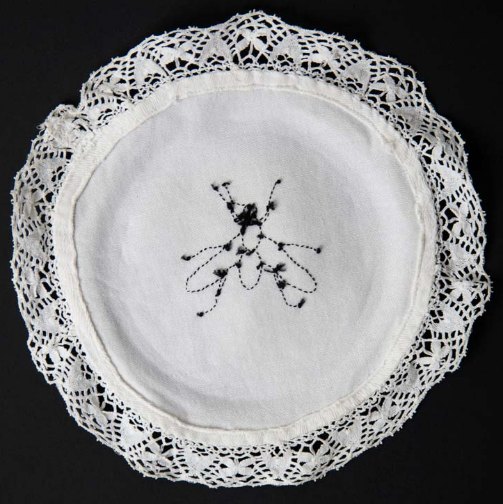 Through Oct. 2.
Through Oct. 2.The first time he saw Vegas he was 14, visiting his father after the divorce, leaving the airport in a Cadillac. From a bleak London neighborhood, Bavington rode into the culture of flash American Etch-A-Sketch.
He'd grown up drawing. Drawing is as natural to him as brushing his teeth or turning on the telly. By the time he met Jeremy Gilbert-Rolfe, Bavington was making good money working on The Simpsons, drawing everything but the animations. (Pick up a Simpsons' calendar or comic book from the '90s, chances are pretty good you're looking at his work.)
Abstraction intrigued him. He followed Dave Hickey's advice and enrolled in graduate school in Las Vegas, where Hickey was on the faculty. Hickey isn't for everybody, but for Bavington, he was key to a wider world.
As a painter, he especially admires abstraction from the '60s, first, Bridget Riley, but also Gene Davis and Kenneth Noland. They were all improvisers from the jazz tradition, but Bavington is not only a planner, he's rock 'n' roll to his boots. When he gets to jazz, it's through rock, as in, John Coltrane from Jimi Hendrix.
Admiration of elders is a necessary first step, locating an artist in a particular territory, but as Lester Young told the teenage drummer Max Roach, "You can't join the throng till you write your own song."
Currently at Greg Kucera, a survey of Bavington's terrain: echoes of Ed Ruscha, but in color, not language.
IT'S GOOD (TO BE FREE), 2008 Synthetic polymer on canvas 54 x 72 inches
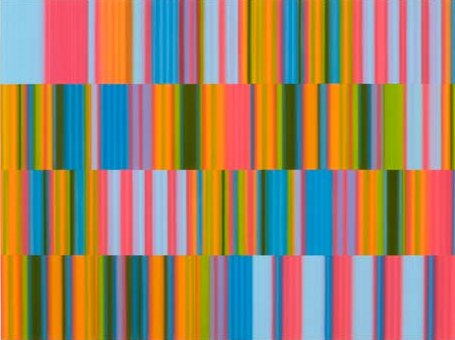 Using synthetic paints, his colors have a digital glow. Their edges are vague, as if their focus
needs adjusting. In their shimmer is a kinder, gentler version of his '60s forerunners. Some of his stripes are based on
commercial bar codes writ large and radiant. Others relate to music. But
instead of the metaphoric music/art tradition of early 20th-century
modernists such as Kandinsky, Bavington's in sync with a wised-up
literalism.
He matches the 12 tones of a musical scale with 12 tones from the color
wheel, assigning each note a particular color, the bandwidth of
each stripe determined by the length of each note with a musical
sequence.
Using synthetic paints, his colors have a digital glow. Their edges are vague, as if their focus
needs adjusting. In their shimmer is a kinder, gentler version of his '60s forerunners. Some of his stripes are based on
commercial bar codes writ large and radiant. Others relate to music. But
instead of the metaphoric music/art tradition of early 20th-century
modernists such as Kandinsky, Bavington's in sync with a wised-up
literalism.
He matches the 12 tones of a musical scale with 12 tones from the color
wheel, assigning each note a particular color, the bandwidth of
each stripe determined by the length of each note with a musical
sequence.
OUT OF TIME, OUT OF TUNE (FRETBOARD), 2010 Synthetic polymer on canvas 12 x 112.5 inches
 Much has been made of Bavington's methods - the match between color and sound a deadpan echo of Kandinsky's early 20th Century efforts to paint music. His success is not in his self-assigned marching orders, however, but in the march itself. His colors are candy, but they have the toughness of black and white.
Much has been made of Bavington's methods - the match between color and sound a deadpan echo of Kandinsky's early 20th Century efforts to paint music. His success is not in his self-assigned marching orders, however, but in the march itself. His colors are candy, but they have the toughness of black and white. Lester Young also warned Max Roach about being a "repeater pencil." Bavington, like Roach way before him, is in no danger of that. His strategies are elastic, with his latest work resembling some sort of merger between Gene Davis and Uta Barth, veering back to Rothko.
JUMP ON IT, 2010 Synthetic polymer on canvas 24 x 24 inches
 Through Oct. 2.
Through Oct. 2.Life With A Star:
I was born here, I knew almost every street, I had my own cafe, my movie house, my newsstand and tobacco shop.Weil faked a suicide so his name would be struck from the Nazis' list; he survived the war in hiding. His characters didn't fare as well.
At one time we all dreamed of miracles and now we didn't like it when they occurred. We would have preferred to live calmly and simply, instead of on the edge of our seats....
Digging our graves, we counted every minute separating us from death. As long as we held the handles of our shovels, as long as our fingers held a handle, as long as our fingers were freezing and the skin on our hands was raw, we were alive...
We would never have admitted that our lives were worthless, because they were our lives, our unique and unrepeatable lives.I thought of these sentences looking at Jesse Edwards' photos of bleak marginalia. Our unique and unrepeatable lives....
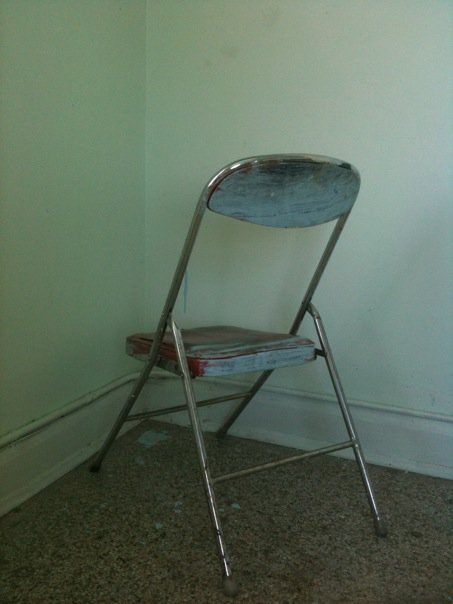
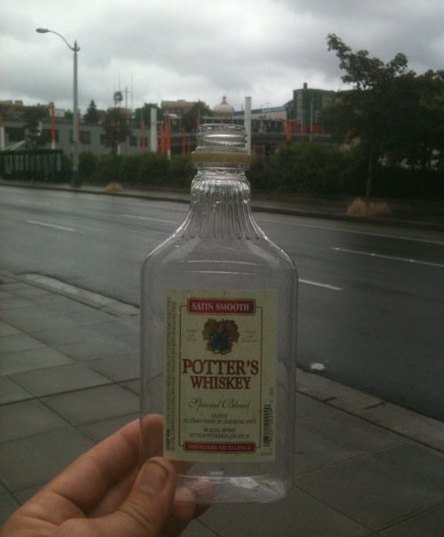 And I thought of the video tribute to The Hooters, below. We are still living in the hangover of those European murders, but as Weil who witnessed them was able to report, the important thing to the victims was not their deaths but their lives.
And I thought of the video tribute to The Hooters, below. We are still living in the hangover of those European murders, but as Weil who witnessed them was able to report, the important thing to the victims was not their deaths but their lives.Three ace P-I business reporters, Todd Bishop, John Cook and Dan Richman, were strolling past the Olympic Sculpture Park, which will open Jan. 20 on the Seattle waterfront. Richman asked his friends what they thought of the eraser. What eraser, asked Cook. Bishop looked around and nodded. Yeah, what eraser?(Photo via)
Cook and Bishop are too young to have used or even seen a typewriter eraser. By the time they were old enough to correct a text, they let their pudgy fingers do the walking and press delete...To somebody who has never seen the original model, Claes Oldenburg's eraser looks like an odd abstraction, maybe an orange wheel attached to a beat-up broom. (more)
Time plucks objects out of its stream and leaves them stranded on the shore. Words too ride a curve around a bend and hurtle forward into a different meaning.
Yeats:
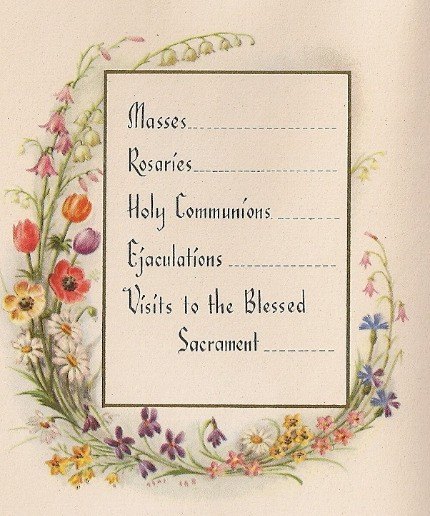
Yeats:
One asks for mournful melodies;Which brings me to a memento of a Catholic school education in the 1950s, sent by Rooney O'Neil. What used to signify a short prayer has a different meaning now.
Accomplished fingers begin to play.
Their eyes mid many wrinkles, their eyes,
Their ancient, glittering eyes, are gay.

From MWnyc, at the Metropolitan Opera House
 From Gala, Appendix Project Space: Tabor Robak
From Gala, Appendix Project Space: Tabor Robak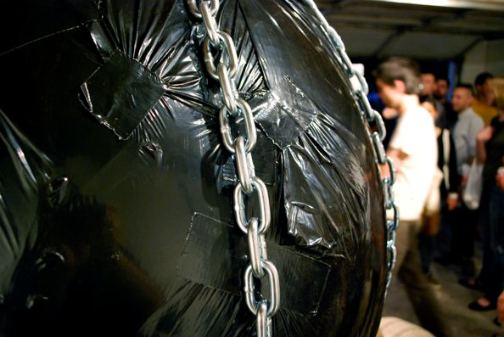 From Emily Pothast, Adam Ekberg's Disco Ball on the Mountain, 2005, via Platform Gallery
From Emily Pothast, Adam Ekberg's Disco Ball on the Mountain, 2005, via Platform Gallery From EllenL, Todd Simeone's Record Cover in a Flash (Air Supply), 2006
Ultrachrome Inkjet print
28" x 28"
Ed. 1 of 3, via James Harris Gallery
From EllenL, Todd Simeone's Record Cover in a Flash (Air Supply), 2006
Ultrachrome Inkjet print
28" x 28"
Ed. 1 of 3, via James Harris Gallery From Jill, Dave Muller's
Centers & Radii b/w
Celebrity Top Tens, via Anthony Meier Fine Arts
From Jill, Dave Muller's
Centers & Radii b/w
Celebrity Top Tens, via Anthony Meier Fine Arts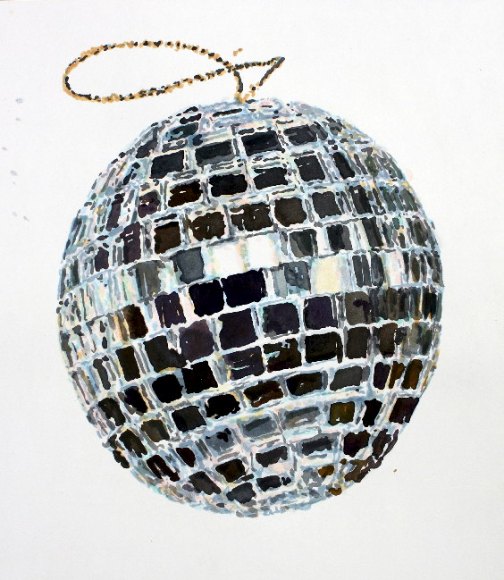 From Netherzone, John Armleder, (first image via)
From Netherzone, John Armleder, (first image via)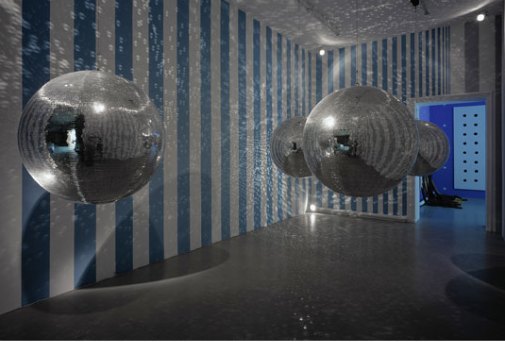
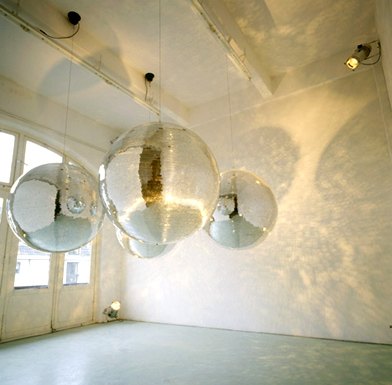 Laura Castellanos, from Laura Castellanos
Laura Castellanos, from Laura Castellanos
Jason Mitchell, Portrait of Scott D. Wilson
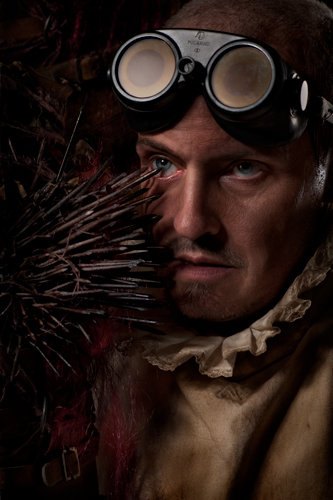 Marsha Burns, from Portraits of Auschwitz and Buchenwald
Marsha Burns, from Portraits of Auschwitz and Buchenwald

Knight:
Never pass judgment on the merits of art you haven't actually seen. I would no more review art from reproductions on a museum's website or in a magazine than I would from seeing it on a TV show. Be there or be square.
My surprise in finding myself stating what I've always thought obvious comes from reading an item posted Wednesday on New York magazine's website. New York's Vulture blog (Editor's note: i.e., Saltz), opines that "Work of Art: The Next Great Artist" created a new way to practice art criticism. In online forums and the comment sections of blogs and across Facebook pages, "people who would otherwise have no access to art-world opinion, criticism or power were given voice."Get thee behind me, Satan, all ye who confuse replicas with the real. Knight argues for an absolute division between real and fake (virtue and vice). I doubt there's an art critic alive who doesn't, on an emotional level, agree with him, especially about painting, even realizing, as John Russell put it, a painting is a "vegetable construct that changes in time."
Really? Art criticism is about having "access" to establishment art-world power? ...
Needless to say, virtually all the "Work of Art" Twitter feeds and comment threads on all the blogs were written by people who -- like me -- have not seen Abdi Farah's paintings, sculptures and drawings, except as mediated through a camera.
Art criticism tends to be pretty low-grade without real access to the art.
In fact, for criticism that's the only access that really matters. The art is where the authentic power does or does not lie. Viewers of Bravo's TV show haven't had that chance, although those who do go to the Brooklyn Museum to see Farah's work can then expound. (more)
A direct encounter is the key that slides into the lock and turns the tumblers, but before getting to the nature of that encounter, let me pause to say that critics who rear up to declaim this first principle as if were a rock solid have begun to sound like Bible thumpers.
I am the Lord your God, who brought you out of the land of Egypt, out of the house of slavery; you shall have no other gods before me. You shall not make for yourself an idol, whether in the form of anything that is in heaven above, or that is on the earth beneath, or that is in the water under the earth. You shall not bow down to them or worship them; for I the Lord your God am a jealous God, punishing children for the iniquity of parents, to the third and fourth generation of those who reject me... (more, always more)To brush up on the complexities of the encounter between viewer and the viewed, I suggest Knight click over to John Perreault's blog and read his entry, Fakes: Have Replicas Replaced the Real? The answer for me is no, as it is for Saltz, for Perreault, for Knight and for all those hundreds of thousands of people who pour every year into art museums instead of being content to click through images on their laptops. But it is a no inside a muddle instead of a clarity. We can't go on, we go on.
Perreault:
At a 2007 conservation workshop at London's Tate, there were "collective gasps" when an original Pevsner, now looking like a "plate of Doritos," was shown next to an image of a recently constructed replica of what it had looked like in its glory day.Nobody settles for replicas; we all settle for replicas. Why is it that when the homicidally-repressive governments in Russian and China cracked open enough to let art in and out, the West found artists who'd evolved their work from premises of Duchamp, Beuys and Warhol, with whom they'd never had a direct encounter? Credit goes to reproductions in illegally obtained art magazines, passed hand to hand.
We can't go on, we go on. No need to be so desperately rude about it. As Carolina Miranda so aptly wrote of Knight, meow!
 Detail:
Detail: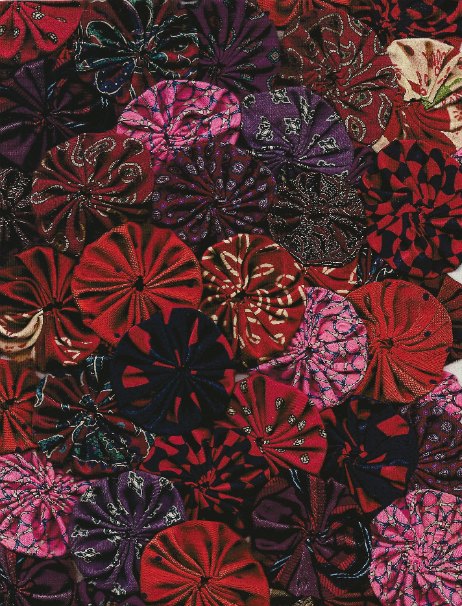
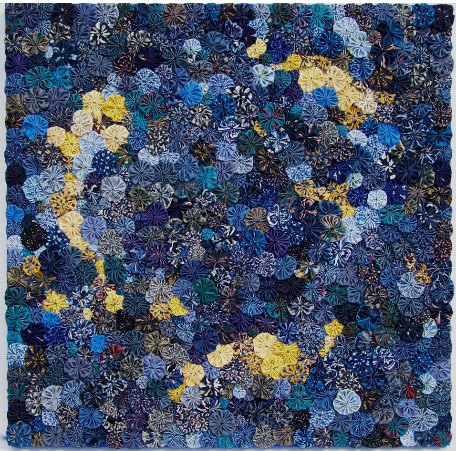 Reducing men's ties to knots (even floral knots), is (however sweetly) an emasculation of the male. Glowen's insistence on the feminine, however, is less a critique of the male than a celebration of a certain kind of woman who is anonymous inside a female sphere: the career-waitress at a cheap diner, the divorcee who picks up her morning paper wearing pom-poms on her slippers, the hat check girl at the roller rink. Be they ever so humble, they dress up.
Reducing men's ties to knots (even floral knots), is (however sweetly) an emasculation of the male. Glowen's insistence on the feminine, however, is less a critique of the male than a celebration of a certain kind of woman who is anonymous inside a female sphere: the career-waitress at a cheap diner, the divorcee who picks up her morning paper wearing pom-poms on her slippers, the hat check girl at the roller rink. Be they ever so humble, they dress up.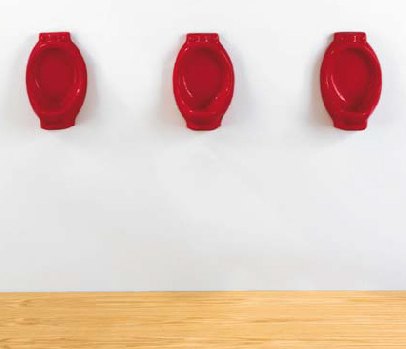 or Sherrie Levine, Fountain (After Marcel Duchamp),
brass, 12 3/4 x 14 1/2 x 24 3/4", 1991...
or Sherrie Levine, Fountain (After Marcel Duchamp),
brass, 12 3/4 x 14 1/2 x 24 3/4", 1991...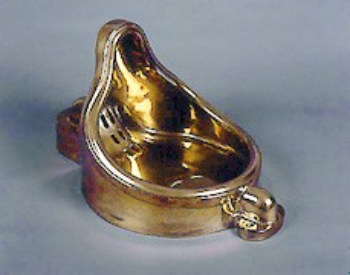 Glowen has more in common with Nancy Drew - Flag Painting (Illuminati)
(45 x 30) glitter on canvas, 2009, after Jasper Johns.
Glowen has more in common with Nancy Drew - Flag Painting (Illuminati)
(45 x 30) glitter on canvas, 2009, after Jasper Johns.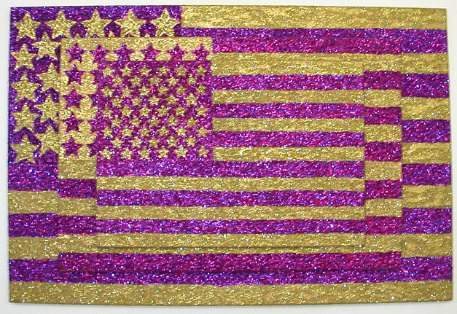 Surrounded by fake flowers and wearing glitter eyeliner, girly-girls don't care what you think. Feminists didn't embrace the type until transvestites had, which means that in these bodies of work, Drew and Glowen derive not from female sources, but male ones.
Surrounded by fake flowers and wearing glitter eyeliner, girly-girls don't care what you think. Feminists didn't embrace the type until transvestites had, which means that in these bodies of work, Drew and Glowen derive not from female sources, but male ones.As Vicki Halper, Seattle crafts curator, put it at the time:
It didn't work as an art museum. If it doesn't work as a craft museum, maybe it can be a cat museum. (more)Halper deftly summarized Seattle's attitude toward its nearest neighbor, the shopping capitol of the region. Seattle does a lot of sneering at Bellevue, but the city's only museum has earned respect. Not only is BAM still here despite the increasingly grim economy, it has racked up serious credit for a strong lineup and an intelligent commitment to artists in the region.
This summer, however, BAM drifted into abject amateur hour.
The Art of Discovery: The Northwest Art Collection of the Junior League of Seattle is a mess. There's good local art here amid the forgettable, but the presentation is completely uncurated. As the admirable Ken Johnson recently observed in another context:
Art just isn't the kind of thing that lends itself to no-budget, laissez-faire populism. You need a higher order of selectivity by and coordination among organizers to produce something that people in the art world are going to feel compelled to see and talk about. (more)Arline Fisch: Creatures of the Deep is too cute for words. It isn't art, and it isn't craft. Maybe, following Halper's prediction, it could pass muster as cat toys.
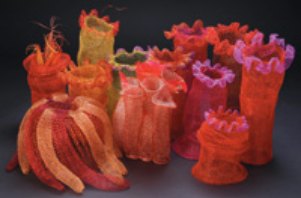 I have high hopes for BAM Biennial 2010: Clay Throwdown! It debuts Aug. 28 with an excellent lineup. Also promising is Ginny Ruffner: Aesthetic Engineering: The Imagination Cycle, opening Oct. 5.
I have high hopes for BAM Biennial 2010: Clay Throwdown! It debuts Aug. 28 with an excellent lineup. Also promising is Ginny Ruffner: Aesthetic Engineering: The Imagination Cycle, opening Oct. 5. With its current lineup, however, BAM is doing its best to confirm its detractors' view. That view remains hearty because of the way BAM closed its doors in 2003. Clay Body had opened three days earlier, set for a three-month run. Its curator, Miriam Sternberg, lost her job in the shuffle, and the three artists featured - Claudia Fitch, Patti Warashina and Akio Takamori - did a lot of work for nothing. Seven years down the road, isn't it time to give that exhibit the run it so richly deserves? Throw in a catalog this time, and bygones will be bygones.
Fitch:
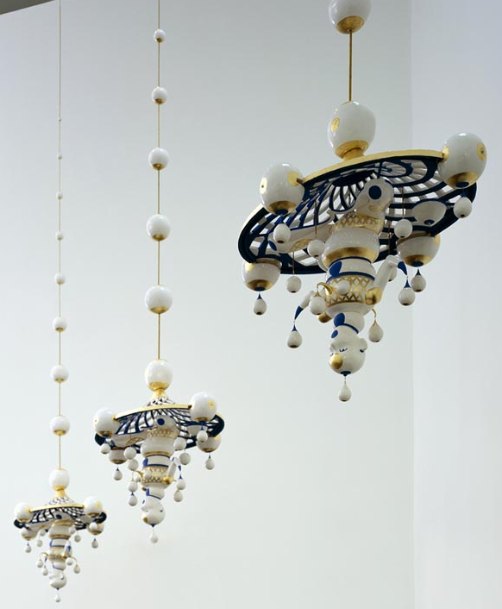 Warashina:
Warashina: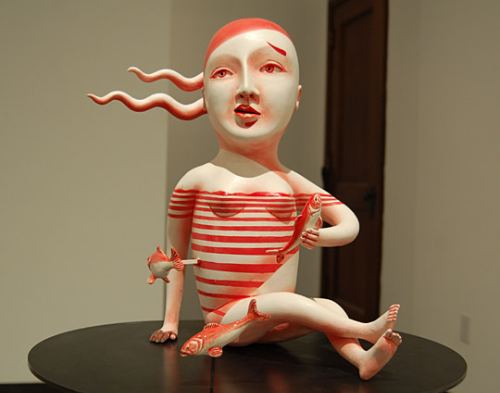 Takamori:
Takamori: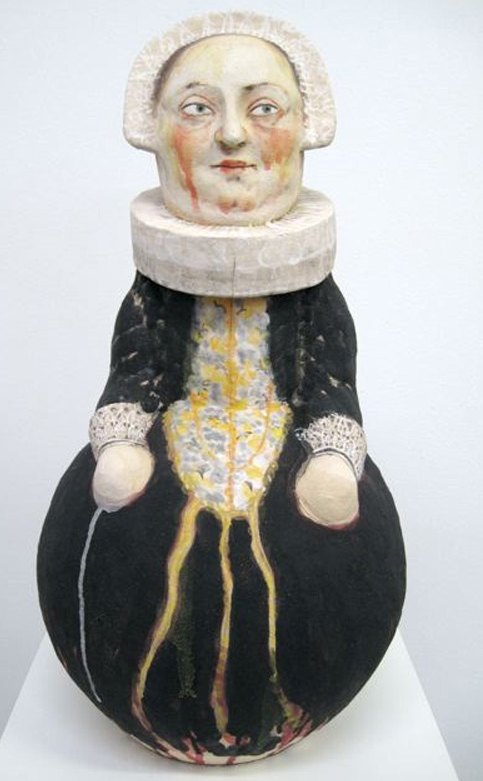
Little that Charles and Emma Frye acquired rises to the ranks of first-rate. Charles Frye saw Modernism as an unworthy aberration. Ida Kaye Greathouse, who followed her husband
Senior curator Robin Held sees it as her job to present the collections in the best possible light. She even brought on staff a specialist in the so-called Munich Secession, to help her. Fine, I thought. Let Jo-Anne Birnie Danzker handle the mixed-bag legacy and allow Held to focus on the contemporary moment. That's her strength and the reason the Seattle audience developed high expectations from a dubious little institution.
Instead, legacy is in the driver's seat. Everything now on view dares to be dull.
First up, Ida Kay Greathhouse: A Tribute. Where are her American greats? Not on view.
John Singer Sargent must have been short of cash to paint the vacuous flattery known as Mrs. Frederick William Roller from 1895. Those to continue to see him as shallow can bolster their viewpoint at the Frye.
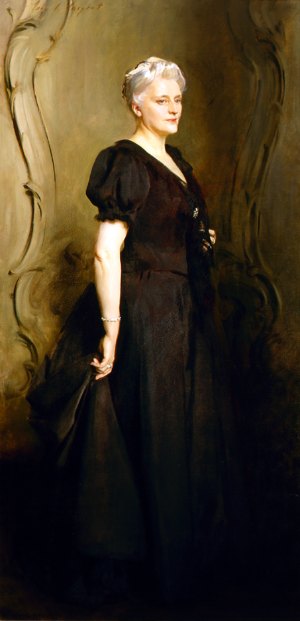 Thomas Moran did his best work at Yellowstone National Park. He's a large part of the reason we have national parks. In Venice in 1908, however, he turned in a poor imitation of Turner.
Thomas Moran did his best work at Yellowstone National Park. He's a large part of the reason we have national parks. In Venice in 1908, however, he turned in a poor imitation of Turner. 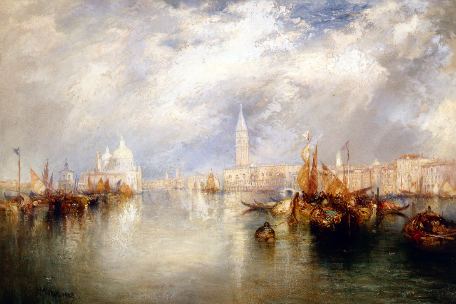 Greathouse adored the Russian expatriate Nicolai Ivanovich Fechin. I imagine she had her pick of that market. Below, Lady in Pink (Portrait of Natalia
Podbelskaya), 1912.
Greathouse adored the Russian expatriate Nicolai Ivanovich Fechin. I imagine she had her pick of that market. Below, Lady in Pink (Portrait of Natalia
Podbelskaya), 1912. 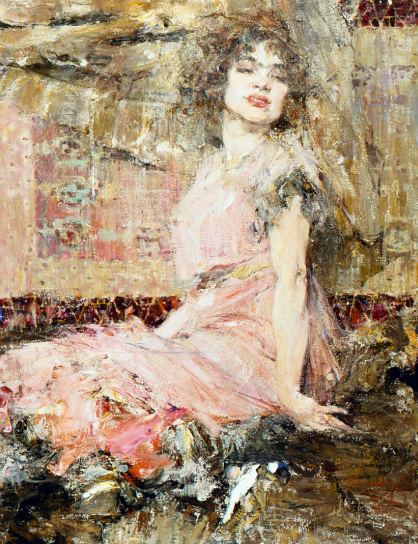 Onward to another Greathouse tick: Northern Latitudes: The Frye and Alaska, featuring Jules Dahlager, Ted Lambert, Sydney Laurence, Fred
Machetanz, Theodore Richardson, Cleveland Rockwell, Jonathan Van Zyle,
and Eustace Ziegler. They're not all terrible painters. I like Rockwell, but why these painters? And why didn't she pick better examples? Most of the ones she brought home are bombastic at best.
Onward to another Greathouse tick: Northern Latitudes: The Frye and Alaska, featuring Jules Dahlager, Ted Lambert, Sydney Laurence, Fred
Machetanz, Theodore Richardson, Cleveland Rockwell, Jonathan Van Zyle,
and Eustace Ziegler. They're not all terrible painters. I like Rockwell, but why these painters? And why didn't she pick better examples? Most of the ones she brought home are bombastic at best. That leaves Tête-à-tête: 150 paintings from the Charles and Emma's overexposed, profoundly mediocre holdings; Fred Machetanz (1908-2002)
Out of kindness I'm skipping the exhibit exclaiming over Charles Frye's entrepreneurial efforts. (He was a meat packer and landlord.) Museums need to remember that's it's OK to take the money, but they don't have to kiss the customer on the lips.
The Frye picks up the pace in the fall.
Opening Oct. 9, still more about the Munich Secession: Séance: Albert von Keller and the Occult, but there's also Implied Violence: Yes and More and Yes and Yes and Why, featuring sculptures, costumes, props, masks, video- and photo-documentation of selected past performances of the Seattle performance group as well as a new performance created for the Frye. That could be good. Who gets the catalog? Keller and his swooning ladies, of course.
Dancers: No Noize (red jacket), Man (back jacket), BJ (striped shirt), Dreal (white shirt). Directed and edited by Yoram Savion, Music by Erk tha Jerk!!
About those injuries, here's a reasonable comment from Sara Marsh:
The intensity has doubled for the contestants this year, which is something that the judges have regularly mentioned. Often, we hear that it's amazing when a dancer performs well in a new style, because last year the dancers weren't expected to be at the same point. There were twice as many of them, and the learning curve was lower. Each contestant danced half as often as they do this year.
I wonder if the new format - picking only the top ten (or eleven, in this case) instead of the top twenty dancers from Vegas week - is taking too great a toll on these young dancers. Injuries like the ones Alex and Ashley sustained are not trifling; these kinds of injuries can get in the way of a dancer's potential and career. (more)Judges on both shows had problems (here and here), not that frustration with those in charge is anything new.
Gabriel Cornelius von Max - "Monkeys as Judges of Art" 1889 (via)
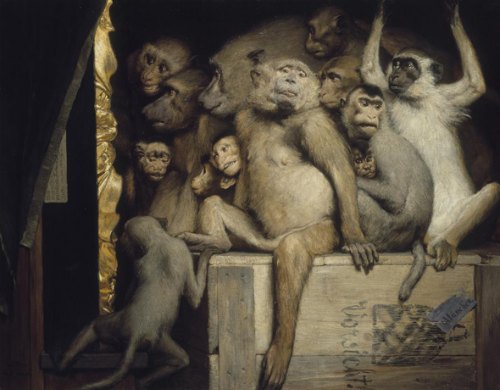 For the finales, both sets of judges pulled themselves together and made a case that they deserve to be there.
For the finales, both sets of judges pulled themselves together and made a case that they deserve to be there. Lauren Froderman won So You Think. Any of the top three would have been good choices. Abdi Farah won Work of Art. By no stretch is he a stellar representative of who's out there, off the major career track and deserving a spot. I was rooting for most of the season Miles Mendenhall but could have voted for Peregrine Honig.
It's true Farah stepped up for the final show, pushing past his insularity and conventional aesthetics to get a toehold into the plausible. Considering the artists working across the country without any particular notice who could have delivered on the show's premises, the original question remains: Who picked these people?
He the man, but what hung over the dance floor continues to make its appearance in art. Below, the disco ball as contributory influence on discards, broken lights, dead planets and chandeliers. Echoing behind all is the music of their sphere: You can tell by the way I use my walk... Rhythm, ladies and gentlemen, rhythm, even when, in David Thompson's phrase, playing torch songs on dead batteries.
Jabu Arnell Disco Ball #2,3 and 4 2009
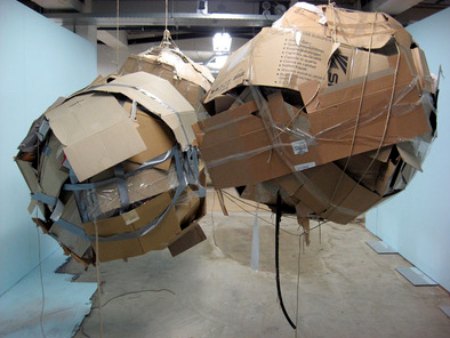 Will Rogan
Will Rogan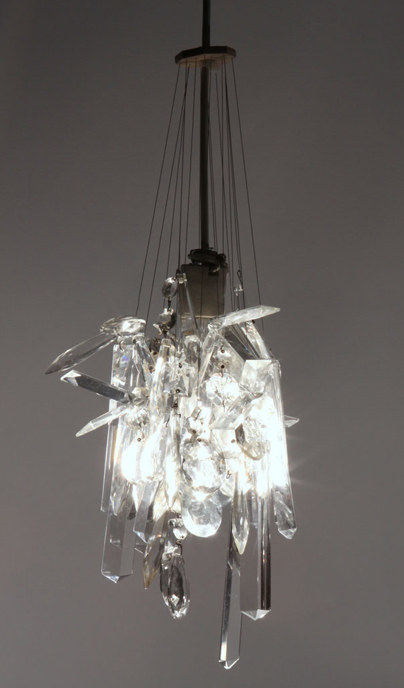 Banks Violette
Banks Violette 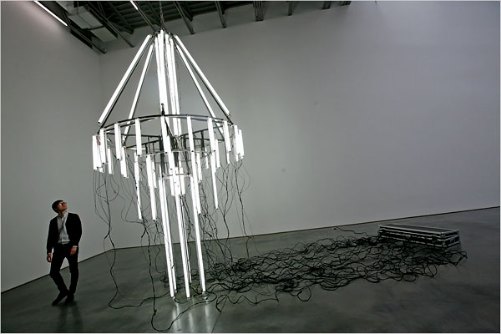 Sasha Frere-Jones
Sasha Frere-Jones Lee Bul
Lee Bul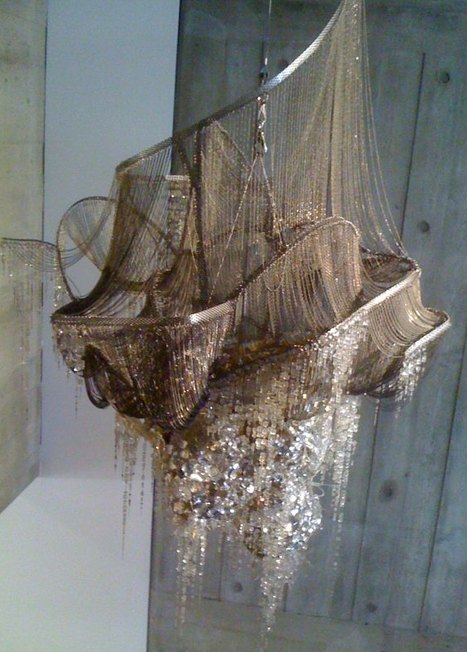 Arnaldo Pomodoro, DISCO bronze with gold patina, 36 inches in diameter, 1966, second artist's proof from an original edition of 3 (via)
Arnaldo Pomodoro, DISCO bronze with gold patina, 36 inches in diameter, 1966, second artist's proof from an original edition of 3 (via)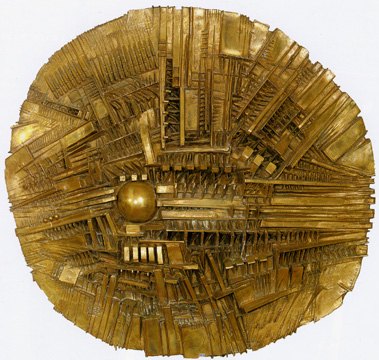 Chris Burden Medusa's Head (American, born 1946)
1990. Plywood, steel, cement, rock, model railroad trains and tracks, 14' (426.7 cm) in diameter.
Chris Burden Medusa's Head (American, born 1946)
1990. Plywood, steel, cement, rock, model railroad trains and tracks, 14' (426.7 cm) in diameter. 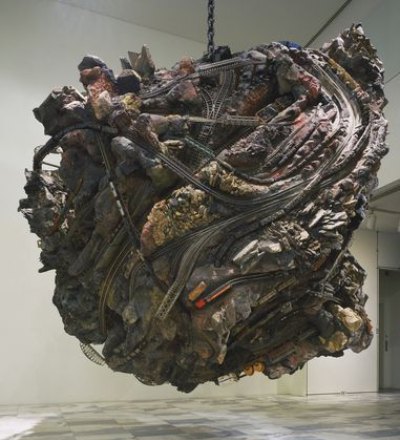 Dan Webb
Dan Webb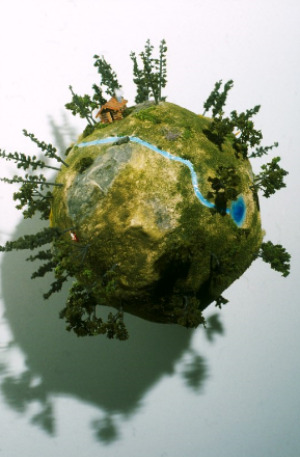
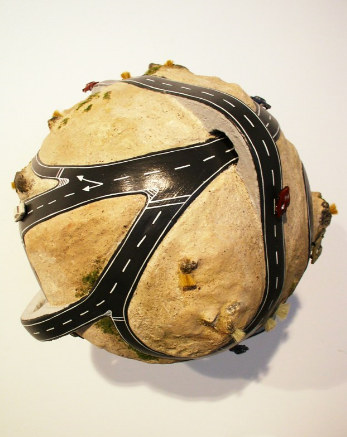 Jack Pierson
Jack Pierson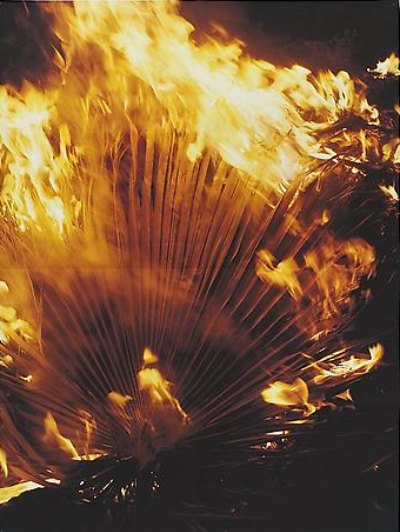 Sam Baron
Sam Baron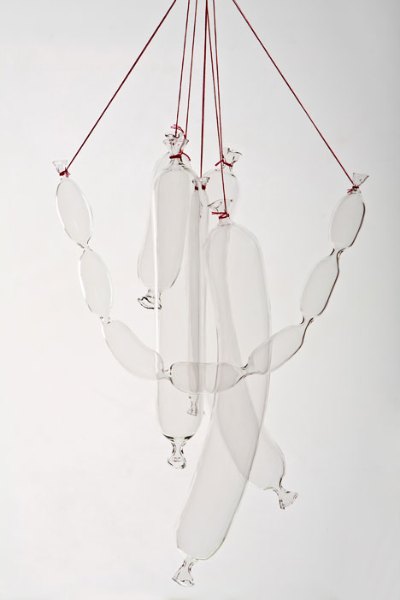 Heide Hinrichs
Heide Hinrichs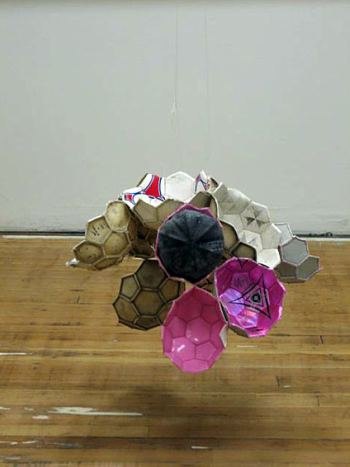 Gretchen Bennett, The dull flame of desire
Gretchen Bennett, The dull flame of desire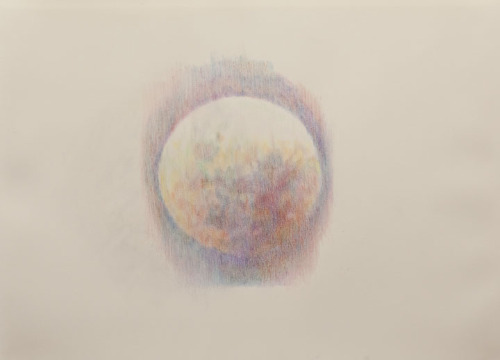 Dale Chihuly
Dale Chihuly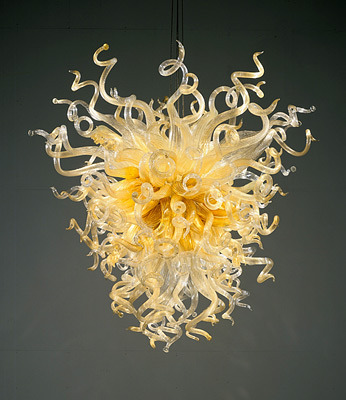
The fair breeze blew, the white foam flew,
The furrow followed free;
We were the first that ever burst
Into that silent sea.
Samuel Beckett
Birth was the death of him.Alice Tippit
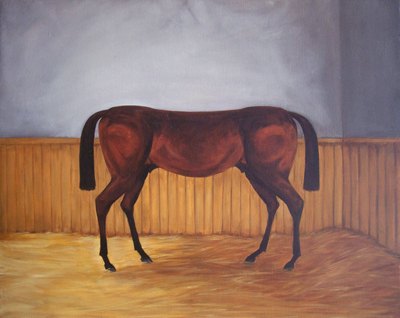 SuttonBeresCuller - Working for a living
SuttonBeresCuller - Working for a living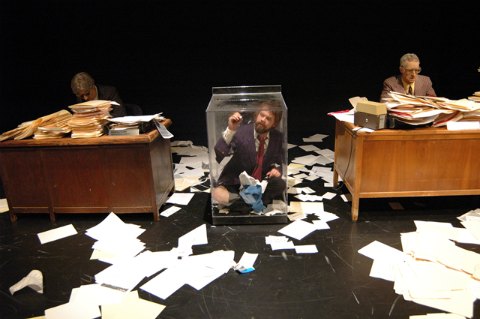 Alex Schweder - Some say the world will end in fire/ Some say in ice...
Alex Schweder - Some say the world will end in fire/ Some say in ice...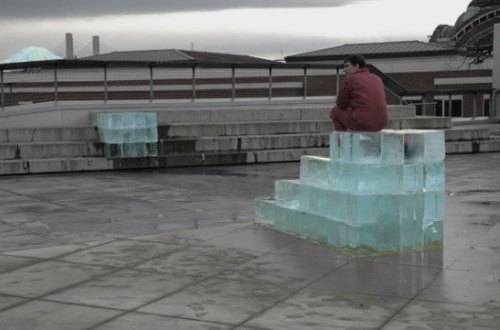 Adam Satushek - a cup to lip problem
Adam Satushek - a cup to lip problem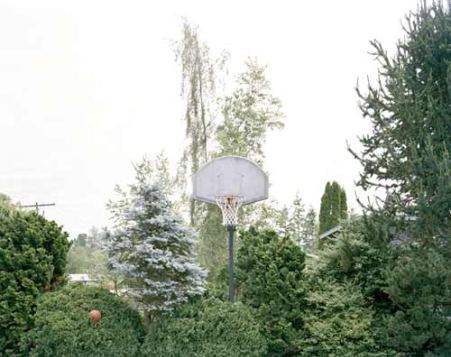 Brian Tolle- building your home on family values
Brian Tolle- building your home on family values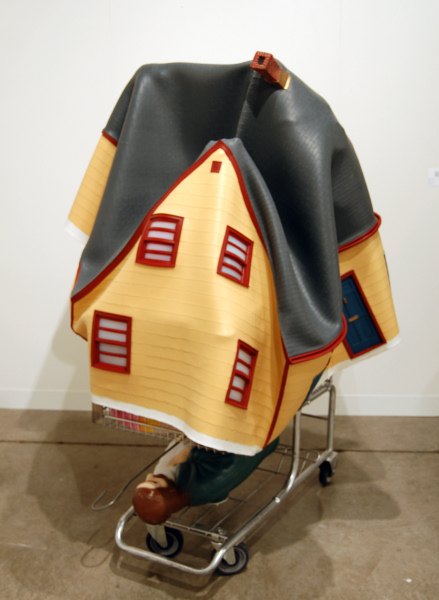 Hans van Meeuwen - We've got to get out of this place
Hans van Meeuwen - We've got to get out of this place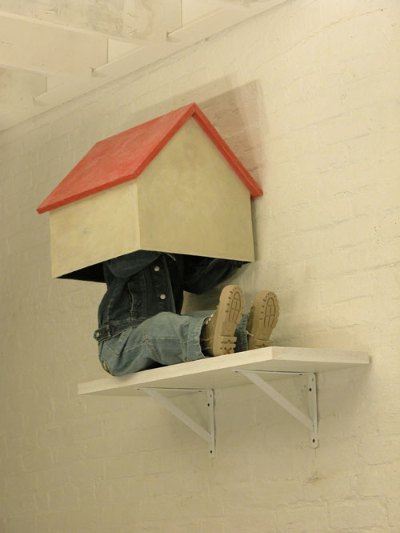 Fred Muram- romancing the unavailable male...
Fred Muram- romancing the unavailable male... 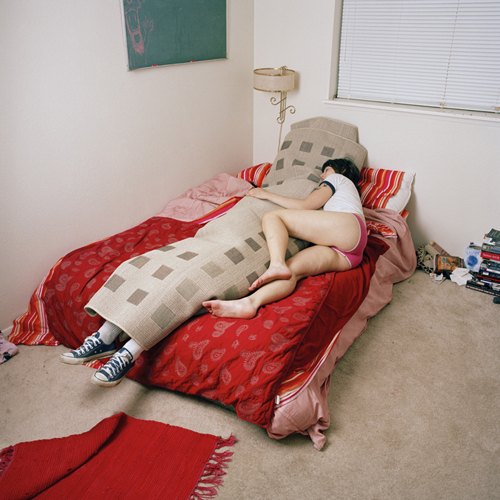 Mark Mumford
Mark Mumford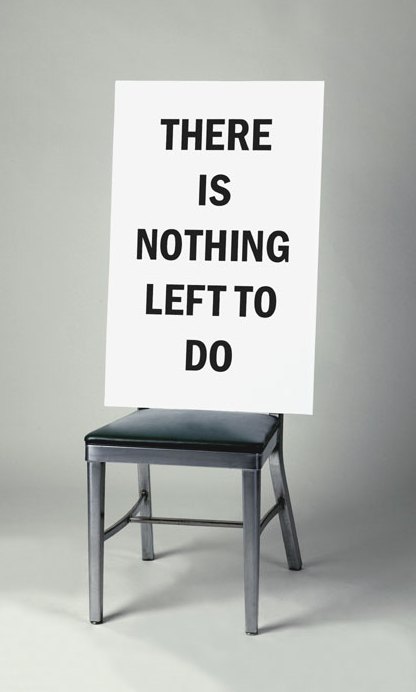
 More from those who are not afraid to go back in order to go forward.
More from those who are not afraid to go back in order to go forward. Dan Carrillo, Jason Hirata, 2010
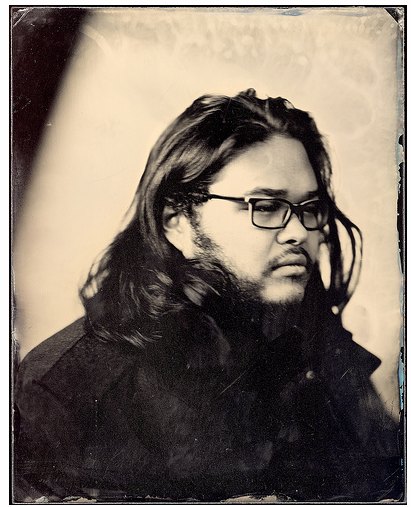 Luis Gonzalez Palma
Luis Gonzalez Palma Carrie Mae Weems
Carrie Mae Weems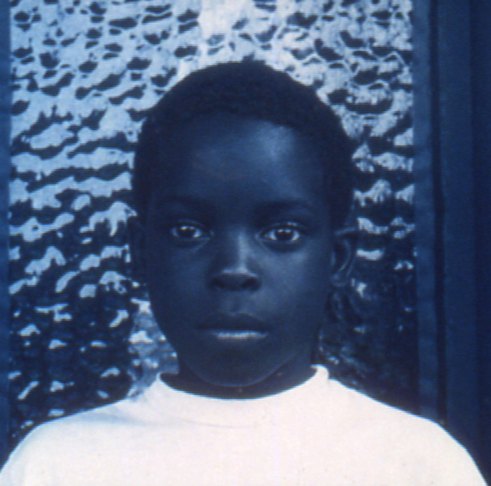 Deborah Luster
Deborah Luster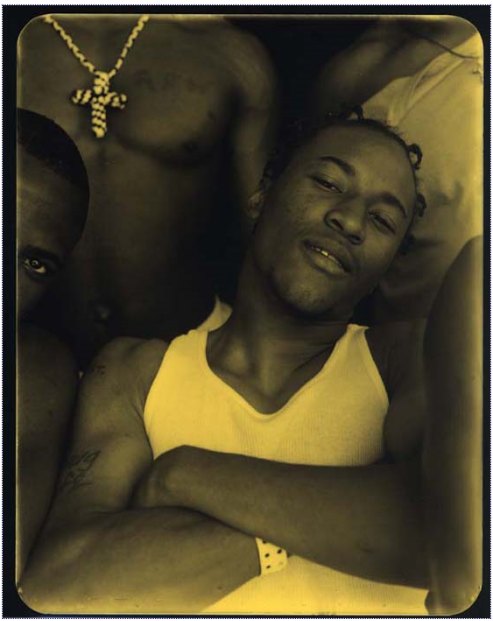
Wolf headdress, late 19th-early 20th century, Quileute, wood, paint, hair, 6 x 13 x 5 ½ in., Courtesy of the National Museum of the American Indian, Smithsonian Institution
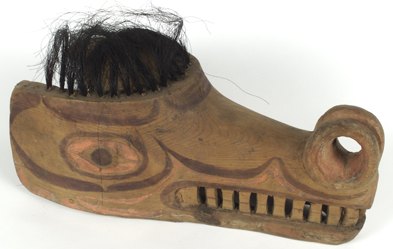 Working with Seattle Art Museum's Barbara Brotherton, curator of Native American art, the tribe has decided to let its objects tell the tale. Behind the Scenes: The Real Story of the Quileute Wolves opens August 14 with a performance by the Quileute tribe, (1-3:30 p.m.) with an exhibition blessing at noon.
Working with Seattle Art Museum's Barbara Brotherton, curator of Native American art, the tribe has decided to let its objects tell the tale. Behind the Scenes: The Real Story of the Quileute Wolves opens August 14 with a performance by the Quileute tribe, (1-3:30 p.m.) with an exhibition blessing at noon. Brotherton
A small Native community, knit together by ancient beliefs, living in their ancestral homelands--a remote coastal village, ringed with primordial forests and in the shadow of Mt. Olympus--seems like a fitting scenario for a supernatural story line. Cast as shape-shifting werewolves in the Twilight saga books and films, opposite a band of sophisticated vampires, the Quileute really do have ties to wolves--but not werewolves!
Quileute oral traditions trace their distinguished ancestry back to myth time when the powerful transformer, Kwa-ti, changed a pair of wolves into the first Quileute people. Thus began a long association with the wolf. I don't know if Stephenie Meyer, author of the Twilight books, knew this but her mention of the mysterious Quileute tribe and an ancient treaty with vampires catapulted their small nation into notoriety.
From my point of view, they have shown remarkable poise in dealing with their new-found fame. In fact, they have collaborated with the museum for the last several months on a special exhibition of their art, most of which has been in the storehouses of major museums, in order to tell the authentic story of their wolf connections. The wolf headdresses, sculptures of spirit beings, rattles, drums, and other objects--some more than 100 years old--were collected at a time when Quileute traditions were suppressed. What you will see when you come to the exhibition at SAM are those old traditions but, more importantly, how they have been kept vital and alive.
Dance criticism is another matter. The school of out-of-it is in session at the Times whenever Alastair Macaulay ventures into the contemporary. In ballet, Macaulay has few peers. He conveys the depth of his understandings with clarity and even elegance. And yet contemporary reminds for him a mystery. Remember that he is
Here's Macaulay's opening sentence for a Mark Morris review:
It's startling to see a work of genius composed largely from movements as basic as walking, running, hopping, skipping, lying down and the like. (more)Startling? Dance made of ordinary movements is, like the found object in art, ubiquitous. More than that. Following Paul Taylor's Esplanade from 1975, it has become the single most important element in dance of the last 35 years. In her review, Arlene Croce heralded Esplanade as conferring "a mythic dimension on ordinary aspects of our daily lives."
I saw it in 1975 and was struck dumb by joy. That version is now available on YouTube, with the endlessly great original dancers.
Jannis Kounellis UNTITLED, 2006 Found wooden tables, bowl, knife, red fish 32 x 172 x 179 inches
 Ann Tuominen
Ann Tuominen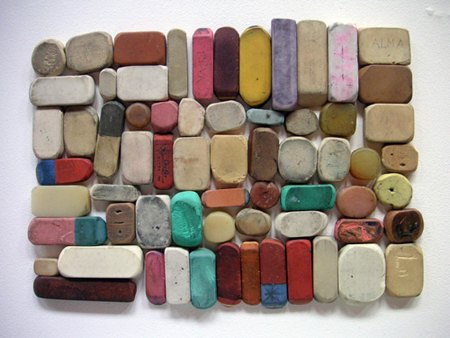 Chris Engman ABANDONED CRATES, 2007
Archival inkjet print
40 x 49 inches
Edition of 6, and THE AUDIENCE, 2004 Archival inkjet print 40 x 48 inches
Chris Engman ABANDONED CRATES, 2007
Archival inkjet print
40 x 49 inches
Edition of 6, and THE AUDIENCE, 2004 Archival inkjet print 40 x 48 inches
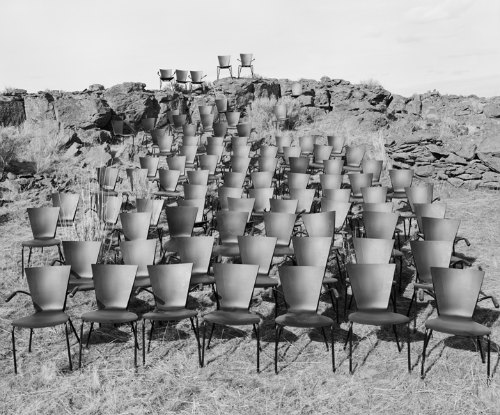 Anissa Mack
Anissa Mack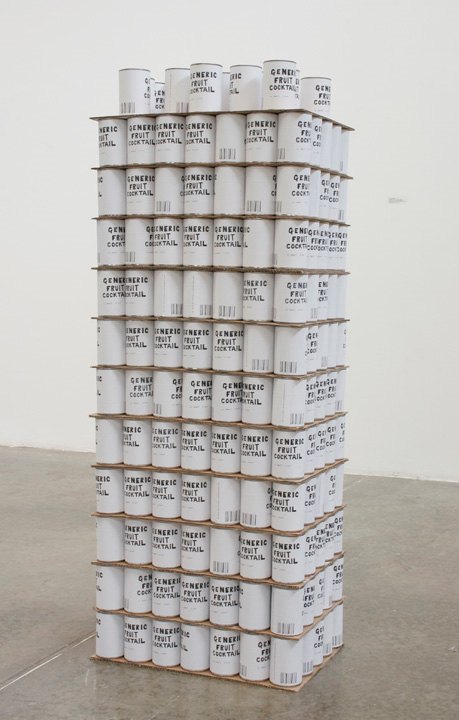 Matt Sellars
Matt Sellars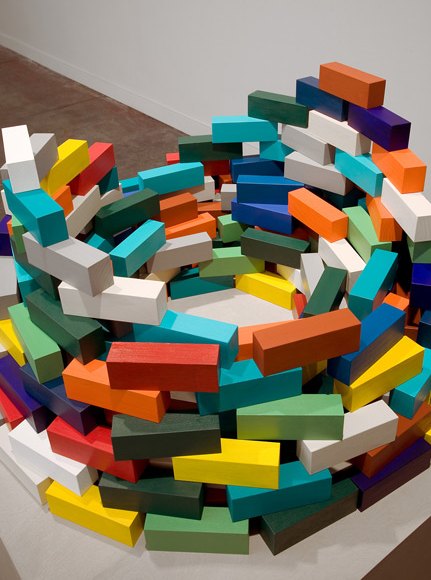 Zelig Kurland File Room, Multnomah County Courthouse
2004 chromagenic print, edition 8
Zelig Kurland File Room, Multnomah County Courthouse
2004 chromagenic print, edition 8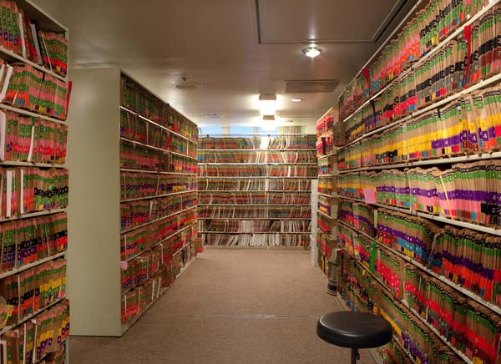 Colleen Wood, Pencils via I'm Revolting
Colleen Wood, Pencils via I'm Revolting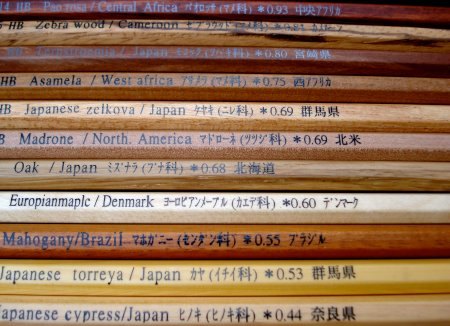 Ed Wicklander He loves his kitties and has the carvings to prove it.
Ed Wicklander He loves his kitties and has the carvings to prove it.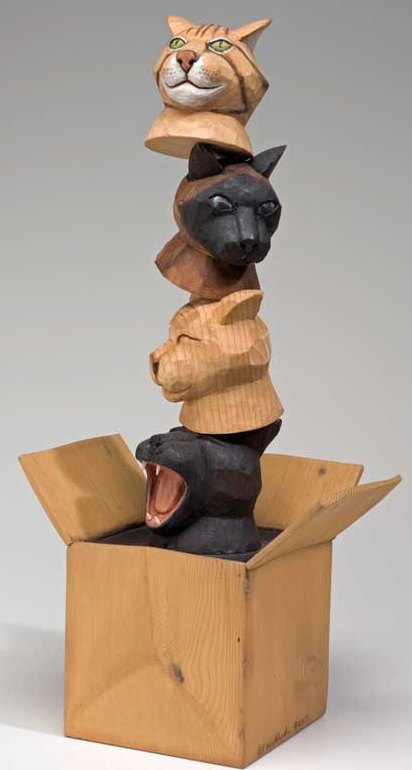 Kate Ericson / Mel Ziegler
Statue of Liberty, 1988
Etched glass jars and paint on metal shelves
72" x 5" x 5"
Kate Ericson / Mel Ziegler
Statue of Liberty, 1988
Etched glass jars and paint on metal shelves
72" x 5" x 5"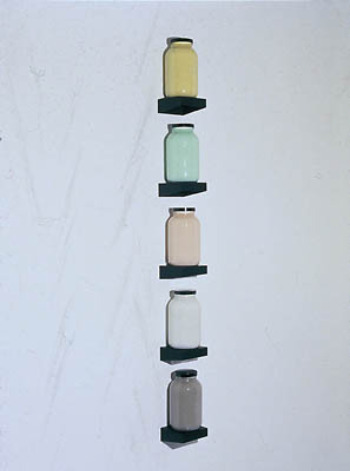 Jonathan Seliger Stretched Snowman, 2007
Automotive enamel on aluminum
99" x 28" x 26"
Jonathan Seliger Stretched Snowman, 2007
Automotive enamel on aluminum
99" x 28" x 26"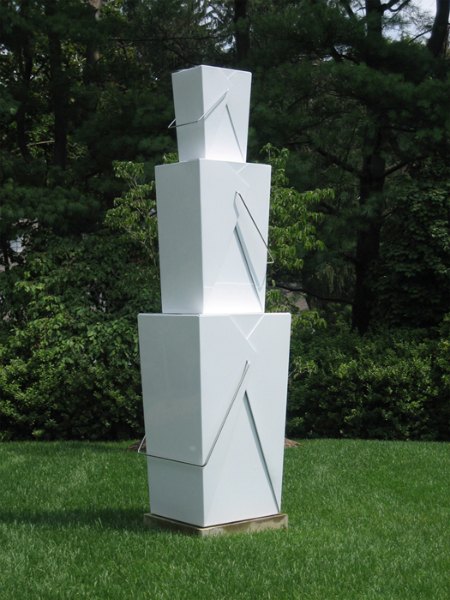 Hart Boyd
Hart Boyd 
 (For more of similar, see Things Organized Neatly.)
(For more of similar, see Things Organized Neatly.)
Dance critics tend to dislike the show, for good reason. (Watch Travis Wall's fake audition in which he crams every slam-bam cliche for which the show is know into a 3-minute, cross-dressing routine that manages while extremely corny, to be great. Choreographer dim, dancer killer.)
But the real problem is the judges.
With her vehement and irrational distaste for first Brandon Bryant and this season's Adechike Torbert, Mia Michaels appears to be unable to bear the sight of heavily muscled black men. (Slender black men are, in her book, OK.) Two geysers of crazy aren't enough evidence of conscious racism, but unconscious? Hell yes, especially because Michaels comes from the unedited id school of criticism. Whatever she's feeling, she says. In the end, unconscious is more insidious. When sleep walkers commit a crime, they wake up indignant at the charge.
In the dance context, however, nothing out of Michaels' mouth comes close to the stupidity of Nigel Lythgoe's comment last week. Addressing a dancer, he said:
You are not the artist at the end of the day. The choreographer is. You are the artist's brush if you like....Following that reasoning, actors aren't artists either. Nor are singers, unless they wrote the song. What about musicians? (Yes to Mendelssohn, no to Isaak Perlman?) I can't remember reading or hearing anything as wrong-headed about an art form. Is he what we have to put up with to see dance on TV? Can Michaels employ a personal diversity trainer to address the root of her problem or will she go on and on, making life hell for the type of male black dancer she fears and/or hates?
Cotton
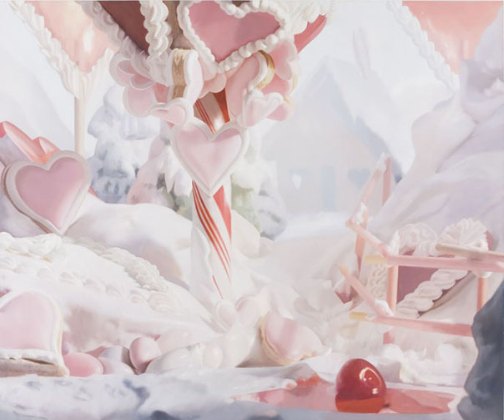 Shot from the video:
Shot from the video: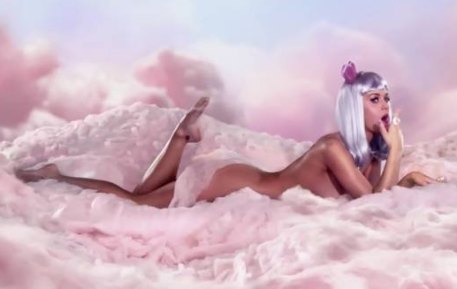 Naturally, teen sites are panting, but we can expect more from art writers, right?
Naturally, teen sites are panting, but we can expect more from art writers, right?Here's Emma Allen on Artinfo:
When someone calls to tell you that candy-sweet pop star Katy Perry is in pastry-loving painter Will Cotton's studio, and will talk to you about the nude portrait she commissioned from him for the cover of her latest album ("Teenage Dream"), but only if you get in a cab immediately, and then run through the streets of the Lower East Side -- well, you do it.A girl's gotta do what a girl's gotta do. Doubtless Perry's Cotton-fueled sensation has sent legions of pop music art directors into art galleries to find another hit maker. I hope they follow Perry's excellent example and pay the artist. Giving the artist credit on the product would also be laudable.
John Grade
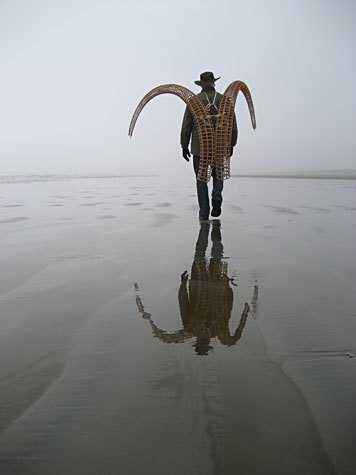 Two: Take your time.
Two: Take your time. Adam Ekberg
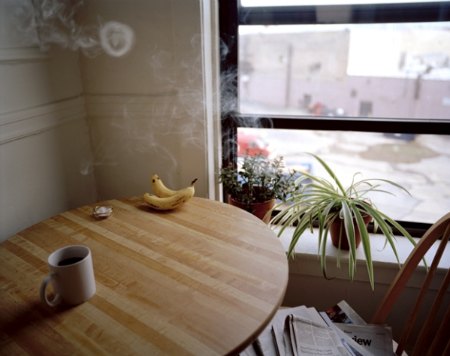 Three: Use your arms.
Three: Use your arms.Roger Ballen

Joel Ross
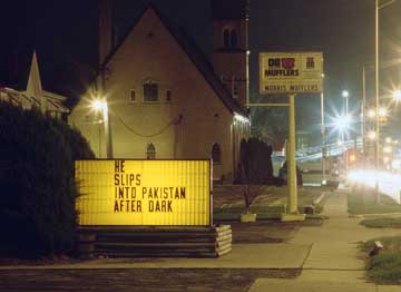 Damaged, brutal, in the wrong against a deeper wrong, we go on, not on their side and not on our own. Given the intractable hatred of their countrymen, what can Afghan women expect from us?
Damaged, brutal, in the wrong against a deeper wrong, we go on, not on their side and not on our own. Given the intractable hatred of their countrymen, what can Afghan women expect from us?Joel Ross
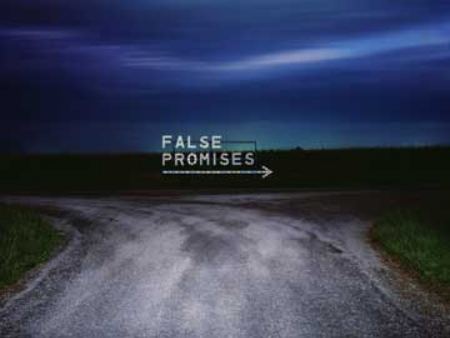
Below, Jack Kerouac. "NIGHT NOTES & Diagrams for ON THE ROAD." Manuscript notes for the novel, November 1949. New York Public Library, Berg Collection, Jack Kerouac Archive, via.
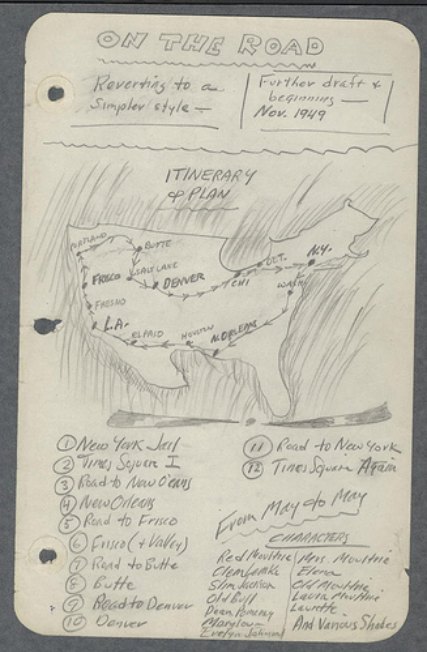
Lee is this year's winner of the Stranger's Genius Award in visual art, which.comes with a cheap cake and a sizable check: $5,000. Lee is the essence anti-spectacle. Her Frequency Map (2007) at Lawrimore Project was a room empty save for the sporadic sound of soft knocking, answered by barely audible raps. When visitors left, the room tried to whistle them back, as if it were a void with needs. The room grew louder as it shuffled through its pickup moves, hoping to score. In Fugue State, hands play across a cast resin pillow, slipping in and out of each other's embrace. A force drives a fuse in Conjugal, thumping through the cotton batting of a mattress interior. Lee tracked oil drops swimming through water in Wake Up as she played Bach on the piano.
Conjugal, 2006, video
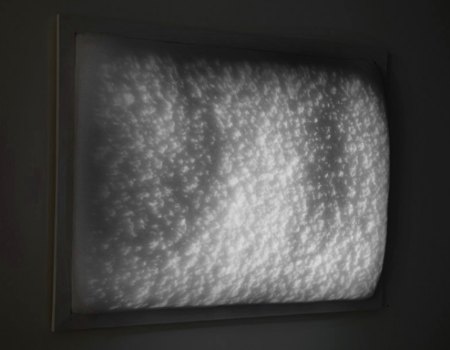 Lee has also served as curator, focused on what a devotion to the muck of clay does to contemporary artists. (Wet and Leatherhard at Lawrimore Project, review here.) Her videos here. Jen Graves on Lee's selection here.
Lee has also served as curator, focused on what a devotion to the muck of clay does to contemporary artists. (Wet and Leatherhard at Lawrimore Project, review here.) Her videos here. Jen Graves on Lee's selection here. In draping a mantle of irony and subversive humor over the spiritual head of the Northwest School, Krafft and Reid were pushing what Krafft called "resurgent regionalism through mythomania." Graves' profile had become fogged with the dewy breath of his mythy-minded admirers, and Krafft and Reid hoped to clear it with satire.
In draping a mantle of irony and subversive humor over the spiritual head of the Northwest School, Krafft and Reid were pushing what Krafft called "resurgent regionalism through mythomania." Graves' profile had become fogged with the dewy breath of his mythy-minded admirers, and Krafft and Reid hoped to clear it with satire. Satire and strategy. Like a Stephen Sondheim stripper in Gypsy, they got nothing against a gimmick.
You can pull all the stops out
Till they call the cops out,
Grind your behind till your banned,
But you gotta get a gimmick
If you wanna get a hand.
Krafft:You can sacrifice your sacro
Workin' in the back row,
Bump in a dump till your dead.
But you gotta get a gimmick
If you wanna get ahead.
We're taking out the sanctimony and adding a bit of titillation. The Northwest mystics were an urban movement, not a bunch of remote dreamers. They didn't have master of fine arts degrees. They learned on the job.Graves:
 Besides membership charters, wristwatches, calendars, trading cards, ashtrays, portable shrines and even a theme song written by Krafft and sung to the tune of The Beverly Hillbillies, what has the Mystic Sons done for us lately?
Besides membership charters, wristwatches, calendars, trading cards, ashtrays, portable shrines and even a theme song written by Krafft and sung to the tune of The Beverly Hillbillies, what has the Mystic Sons done for us lately?Reid is glad you asked.
Thursday night, 5:00 to 8:00 at 3 galleries in the Tashiro Kaplan compound (Rock/DeMent, the Corridor, and Angle galleries at 306 S. Washington St) is a Graves' tribute invitational, with a Graves séance on August 28, what would have been Graves' 100th birthday.
Morris Graves, Self Portrait, (left); John Ohannesian, Morris Graves (right)

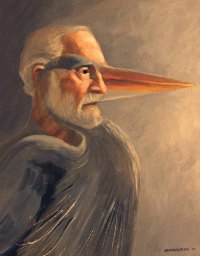
(Reid's press release after the jump.)
Continue reading Mystic Sons of Morris Graves.
Using posters from a Mumbai-based Hindi-language film industry, artists throw in Indian miniatures, traveling carnivals, folk paintings in a florid vein and Mexican shrines with an occasional touch of anime.
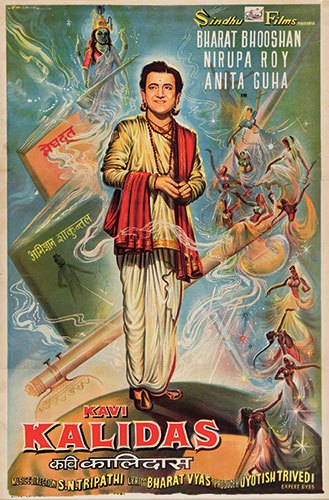 Below, Bollywood fellow travelers.
Below, Bollywood fellow travelers.Namita Kapoor
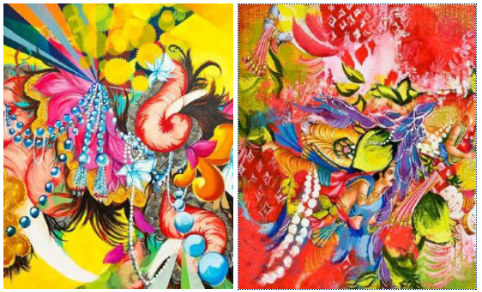 Timothy Siciliano Torture in pastel shades.
Timothy Siciliano Torture in pastel shades.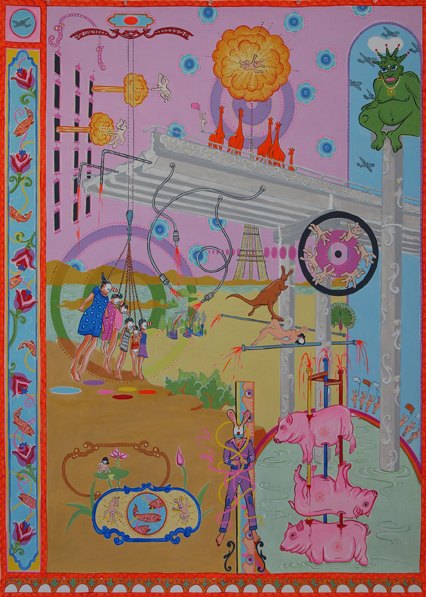 Donald Fels Even the Wizard of Oz is working for a living.
Donald Fels Even the Wizard of Oz is working for a living.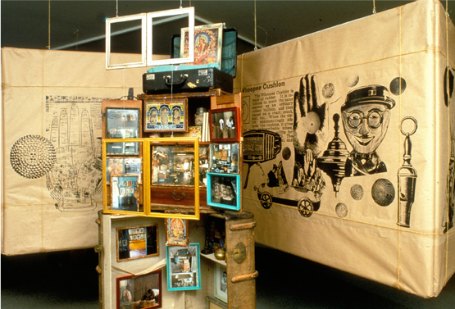 Lari Pittman Remote but dreamy. The veil covers nothing.
Lari Pittman Remote but dreamy. The veil covers nothing. Also Lari Pittman:
Also Lari Pittman: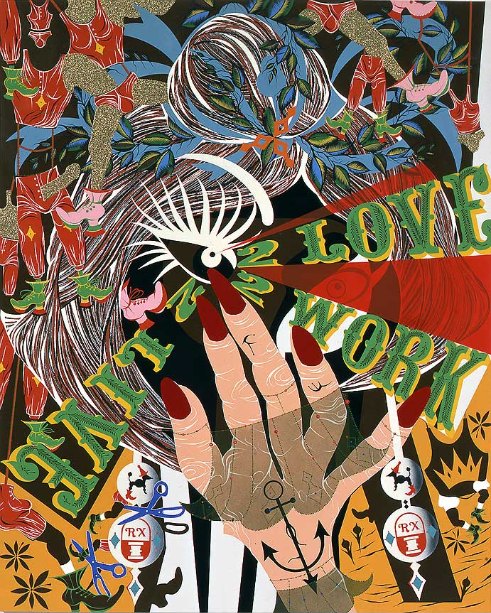 Cheryl dos Remedios Chinese dragon (five claws for the emperor) in a girl's girl narrative.
Cheryl dos Remedios Chinese dragon (five claws for the emperor) in a girl's girl narrative.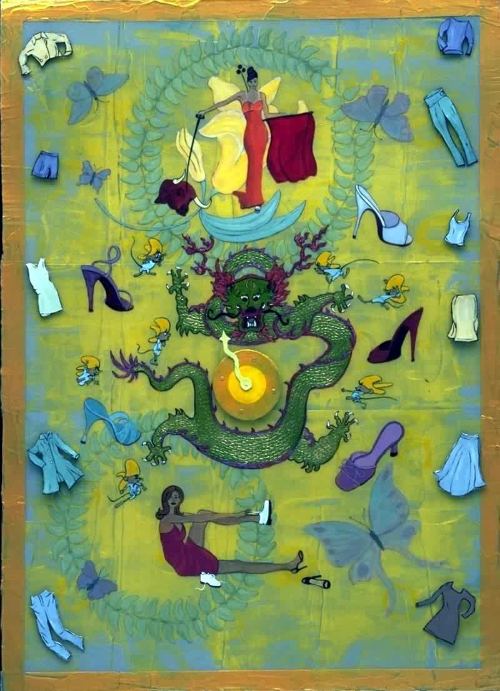 Manish Arora Who needs to sit down?
Manish Arora Who needs to sit down?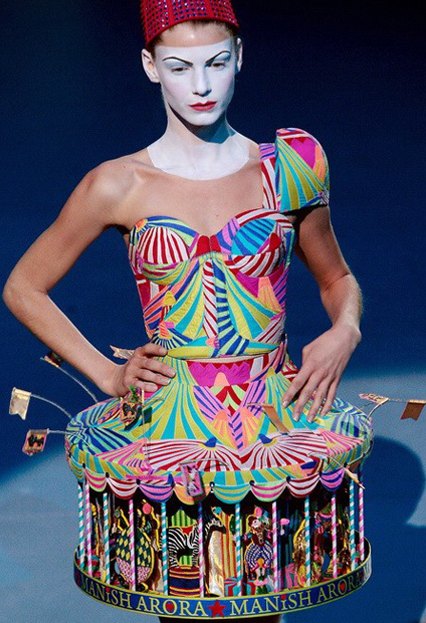 Maki Tamura- Everything together.
Maki Tamura- Everything together. Angela Fraleigh. Overheated romance, anyone?
Angela Fraleigh. Overheated romance, anyone?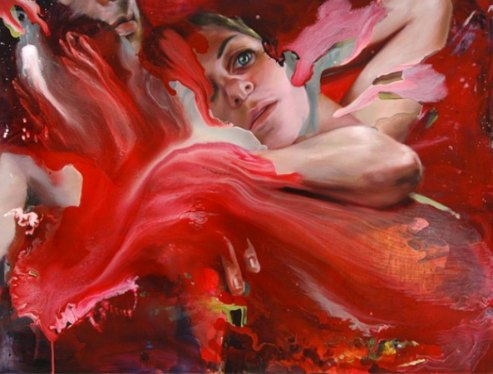 Finally, more Bolly than Holly, a fake movie campaign from Eva and Franco Mattes.
Finally, more Bolly than Holly, a fake movie campaign from Eva and Franco Mattes.
Platform opened with four partners. Stephen Lyons is the only one left, and he runs it by himself. Even though he no doubt he needs a vacation, why pick August? Seattle collectors tend to stay in town, plus it's high tourist season, attracting those who are sweltering where they live.
Ambach & Rice has been lights out since June 27. Its website reports it will reopen August 14, but with what? That space is a blank. No news is not necessarily good news. I'd hoped the gallery would use its time out to upgrade its website, adding, for instance, images to its list of artists represented. Alas, no. Under each artist's name is the caption, "More information coming soon." That's soon in turtle time.
Lawrimore Project has scheduled nothing past the close of its Isaac Layman show, ending August 14. (Click the Layman link for more on LP's still mysterious plans.) Fetherston Gallery's last scheduled exhibit closed June 12th. Grey Gallery closed its Capitol Hill space on June 19 and is still looking for a new one. Ohge is out May 15-Sept 1.
The open-with-bells-on crowd includes:
Soil: Xanadu: A Stately Pleasure Dome. Group show including Amanda Manitach's Glory, Utopia (the head of Samuel Taylor Coleridge on the body of Terpischore) Charcoal and pastel. Opens Thursday night, 6-8.
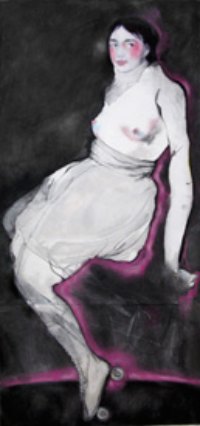 Ouch My Eye is having a yard sale 5-11 p.m., also the opening for a group show.
Ouch My Eye is having a yard sale 5-11 p.m., also the opening for a group show. Punch Gallery: Orange Crush. Yes, gallery artists explore orange. (Wasn't Punch artist Ries Niemi recently deploring the prevalence of cute curatorial ideas?) Thursday night opening, 6-8.
Traver: Dante Marioni, opening Thursday night, 6-8.
 Francine Seders: Juan Alonzo and Marita Dingus, opening August 13, reception August 15, 2-4 p.m.
Francine Seders: Juan Alonzo and Marita Dingus, opening August 13, reception August 15, 2-4 p.m.Alonzo:
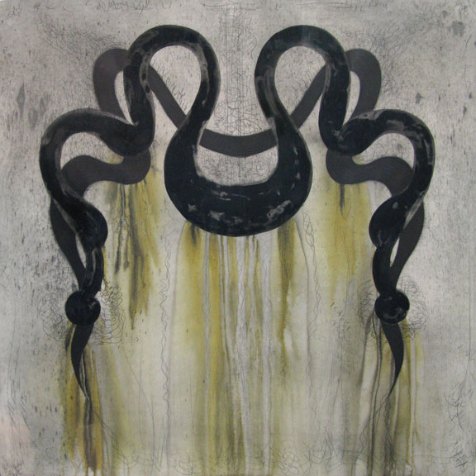 Dingus:
Dingus: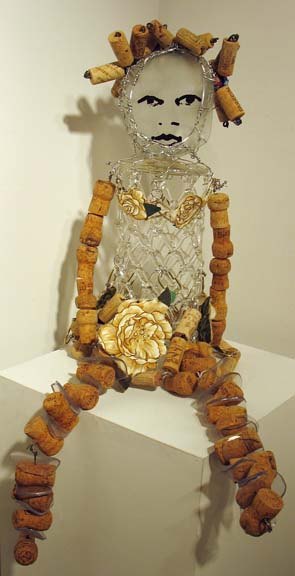 Greg Kucera: Tim Bavington opens August 19, reception that night, 6-8
Greg Kucera: Tim Bavington opens August 19, reception that night, 6-8.
 Winston Wachter: My Summer Vacation continues through Aug. 27, including:
Winston Wachter: My Summer Vacation continues through Aug. 27, including:Zack Bent
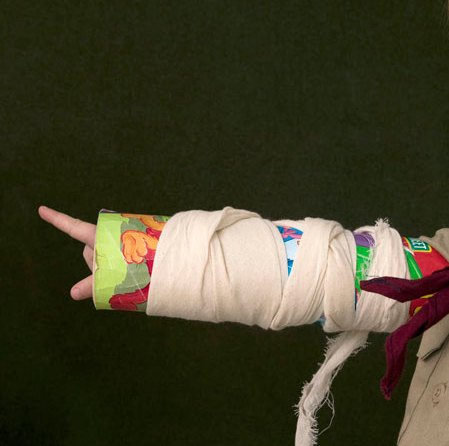 and Buddy Bunting.
and Buddy Bunting.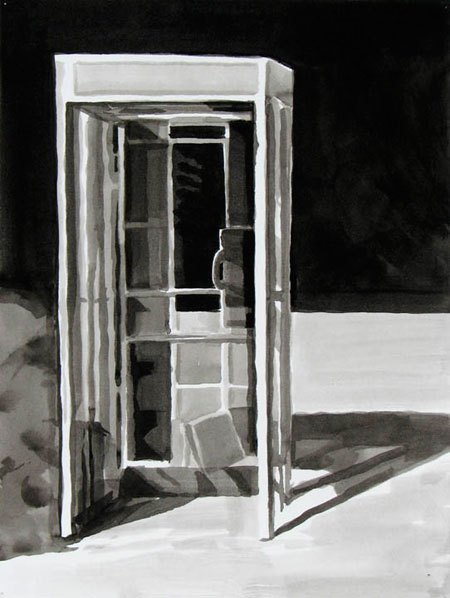
As an artist, I always resent these stupid theme shows. Only one step removed from those plastic cows that "artists" decorate for charity, or the inane competitions on Work of Fart on TV. Mini Golf, in particular, is a recurring curatorial cop out. It keeps cropping up, for well over 30 years now. First one I remember was in NYC, in the 70's, but there were probably some before that....Why is it only visual artists get subjected to these idiotic themes, these "fun ideas"? How come famous poets aren't asked to all write poems about Cupcakes for an anthology? ... Good art does not come at the request of a curator to fit into a "fun" category that everyone can relate to. Sure, once in a while some of these show produce interesting, or at least amusing, shadows of what the artist could really do if left unmolested. But by and large, they are an example of intellectual laziness on the part of exhibiting spaces and curators, and pandering to the lowest common denominator. Now, I gotta go, and make my piece for the upcoming show about Tube Socks...Yes indeed, except of course, it depends. Even the most unpromising premises can deliver, given the right artists. The right artists are usually those who are there already. It's the difference between a curator who thinks about corners because she notices artists are working there, and a curator who asks artists who've never done a corner piece to make one for her. The former has a better chance of scoring than the latter.
Back to golf. An easy way to sink the art ball is to invite Charles McGill (aka Arthur Negro) to participate. Not only does he make his own golf bags....
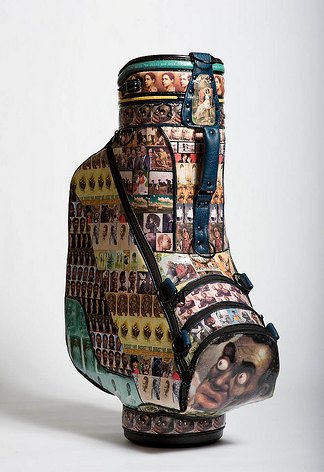 ...he's founder of the moving golf course known as Club Negro and the website, ArtNegro.com.
...he's founder of the moving golf course known as Club Negro and the website, ArtNegro.com.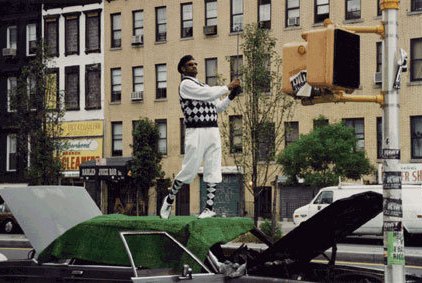
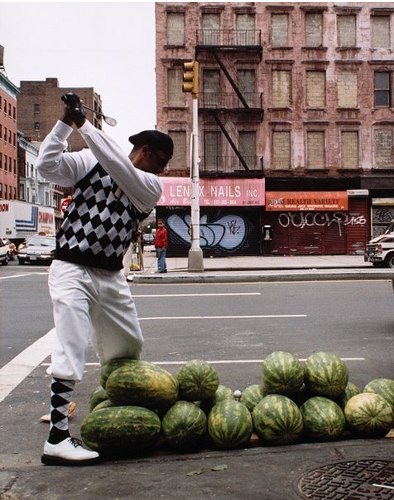 McGill:
McGill: Arthur Negro, the clubs first and only Golf Brofessional, has fulfilled his dream of creating a secluded and tranquil place where former black militants can focus on things more personal to them; A place where the daily pressures of changing the world can be left on the practice putting green and where their inherent desire for individuality can be realized, somewhere between the first tee and the 18th green.
About
Blogroll
AJ Blogs
AJBlogCentral | rssculture
About Last Night
Terry Teachout on the arts in New York City
Terry Teachout on the arts in New York City
Artful Manager
Andrew Taylor on the business of arts & culture
Andrew Taylor on the business of arts & culture
blog riley
rock culture approximately
rock culture approximately
critical difference
Laura Collins-Hughes on arts, culture and coverage
Laura Collins-Hughes on arts, culture and coverage
Dewey21C
Richard Kessler on arts education
Richard Kessler on arts education
diacritical
Douglas McLennan's blog
Douglas McLennan's blog
Dog Days
Dalouge Smith advocates for the Arts
Dalouge Smith advocates for the Arts
Flyover
Art from the American Outback
Art from the American Outback
lies like truth
Chloe Veltman on how culture will save the world
Chloe Veltman on how culture will save the world
Life's a Pitch
For immediate release: the arts are marketable
For immediate release: the arts are marketable
Mind the Gap
No genre is the new genre
No genre is the new genre
Performance Monkey
David Jays on theatre and dance
David Jays on theatre and dance
Plain English
Paul Levy measures the Angles
Paul Levy measures the Angles
Real Clear Arts
Judith H. Dobrzynski on Culture
Judith H. Dobrzynski on Culture
Rockwell Matters
John Rockwell on the arts
John Rockwell on the arts
State of the Art
innovations and impediments in not-for-profit arts
innovations and impediments in not-for-profit arts
Straight Up |
Jan Herman - arts, media & culture with 'tude
Jan Herman - arts, media & culture with 'tude
dance
Foot in Mouth
Apollinaire Scherr talks about dance
Apollinaire Scherr talks about dance
Seeing Things
Tobi Tobias on dance et al...
Tobi Tobias on dance et al...
jazz
Jazz Beyond Jazz
Howard Mandel's freelance Urban Improvisation
Howard Mandel's freelance Urban Improvisation
ListenGood
Focus on New Orleans. Jazz and Other Sounds
Focus on New Orleans. Jazz and Other Sounds
Rifftides
Doug Ramsey on Jazz and other matters...
Doug Ramsey on Jazz and other matters...
media
Out There
Jeff Weinstein's Cultural Mixology
Jeff Weinstein's Cultural Mixology
Serious Popcorn
Martha Bayles on Film...
Martha Bayles on Film...
classical music
Creative Destruction
Fresh ideas on building arts communities
Fresh ideas on building arts communities
The Future of Classical Music?
Greg Sandow performs a book-in-progress
Greg Sandow performs a book-in-progress
Overflow
Harvey Sachs on music, and various digressions
Harvey Sachs on music, and various digressions
PianoMorphosis
Bruce Brubaker on all things Piano
Bruce Brubaker on all things Piano
PostClassic
Kyle Gann on music after the fact
Kyle Gann on music after the fact
Sandow
Greg Sandow on the future of Classical Music
Greg Sandow on the future of Classical Music
Slipped Disc
Norman Lebrecht on Shifting Sound Worlds
Norman Lebrecht on Shifting Sound Worlds
The Unanswered Question
Joe Horowitz on music
Joe Horowitz on music
publishing
book/daddy
Jerome Weeks on Books
Jerome Weeks on Books
Quick Study
Scott McLemee on books, ideas & trash-culture ephemera
Scott McLemee on books, ideas & trash-culture ephemera
theatre
Drama Queen
Wendy Rosenfield: covering drama, onstage and off
Wendy Rosenfield: covering drama, onstage and off
visual
Aesthetic Grounds
Public Art, Public Space
Public Art, Public Space
Another Bouncing Ball
Regina Hackett takes her Art To Go
Regina Hackett takes her Art To Go
Artopia
John Perreault's art diary
John Perreault's art diary
CultureGrrl
Lee Rosenbaum's Cultural Commentary
Lee Rosenbaum's Cultural Commentary
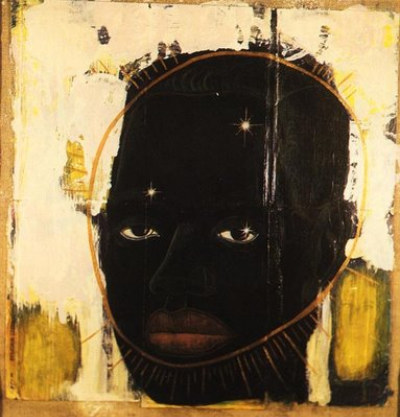
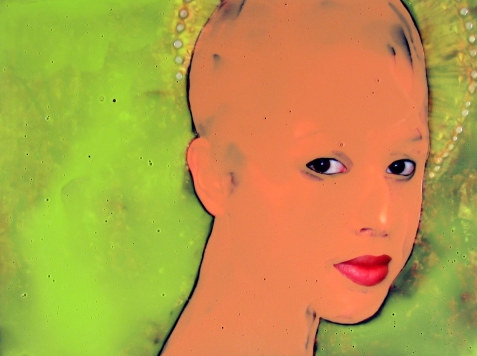
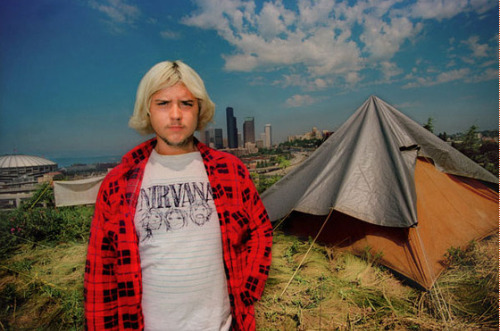
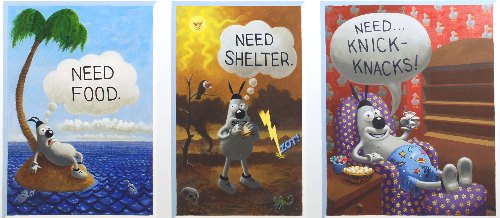
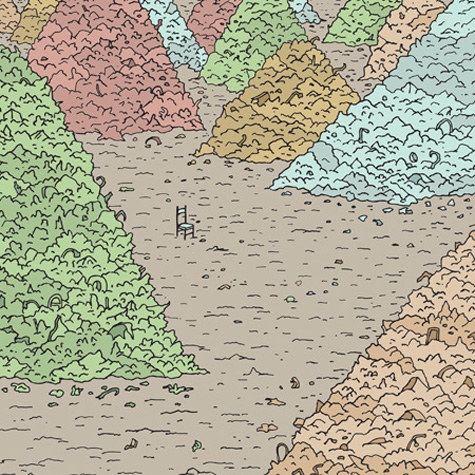
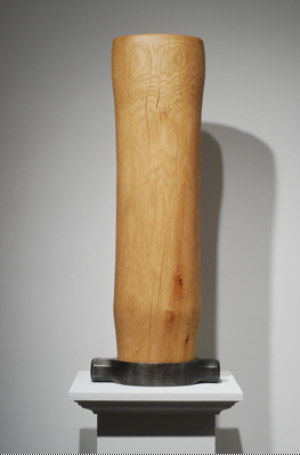

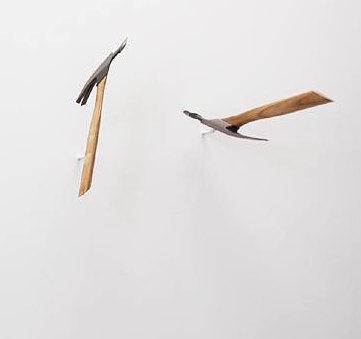

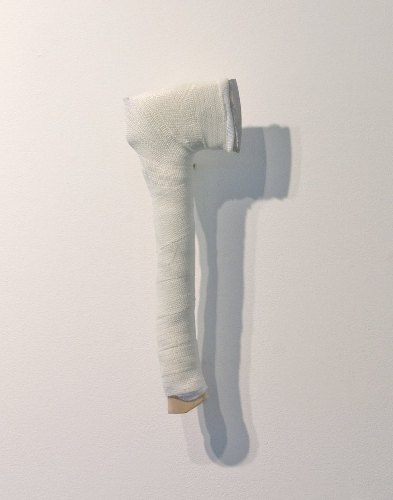
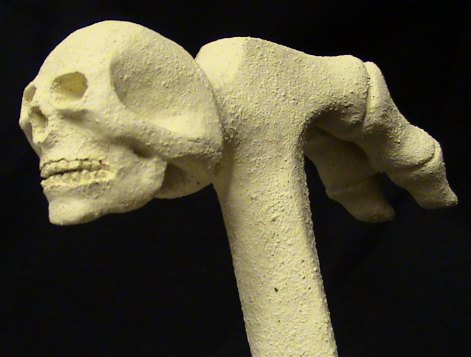 Yoko Ono,
Yoko Ono, 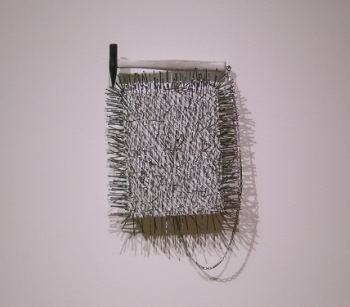
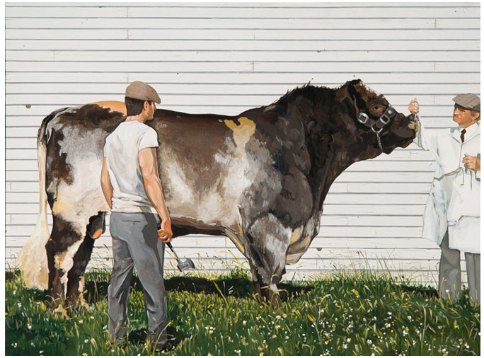
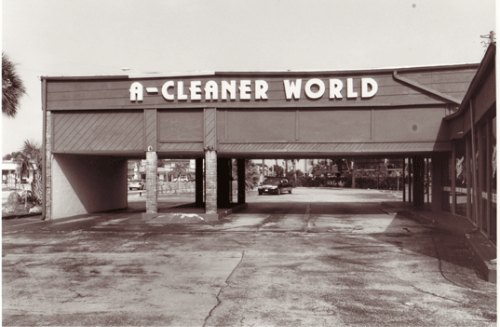

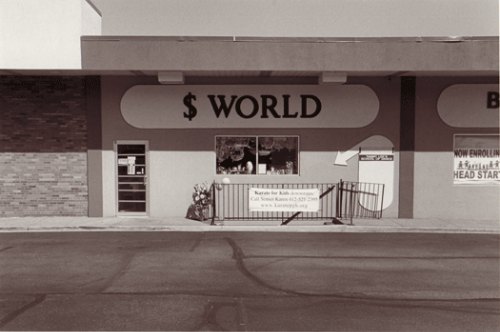

 detail:
detail: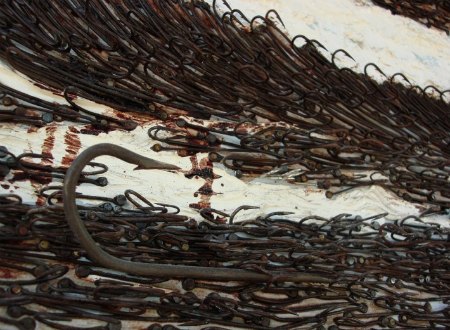


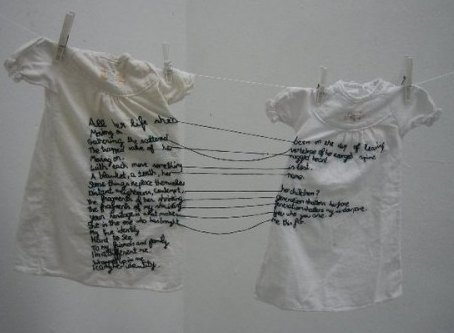
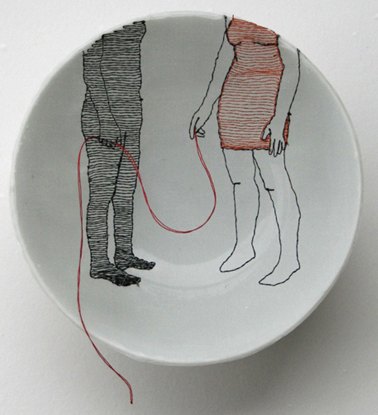
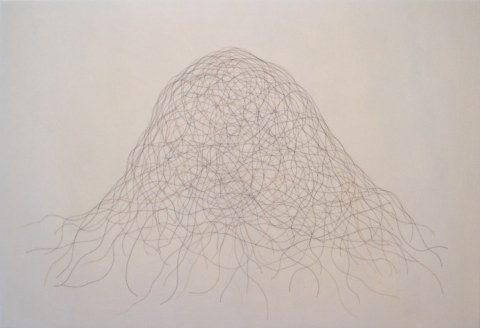
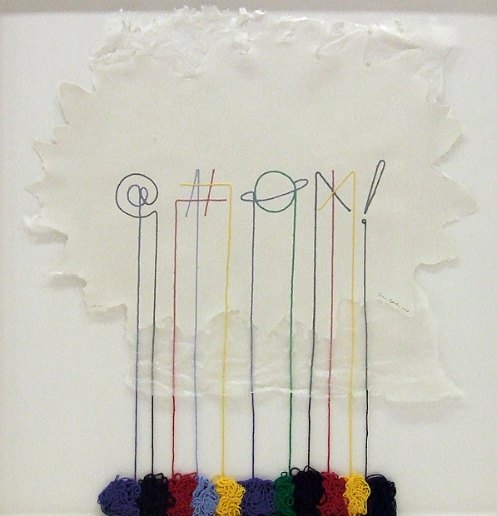
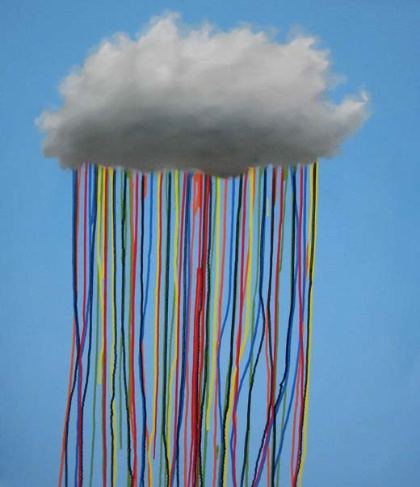
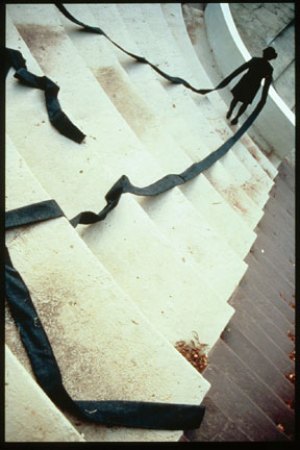
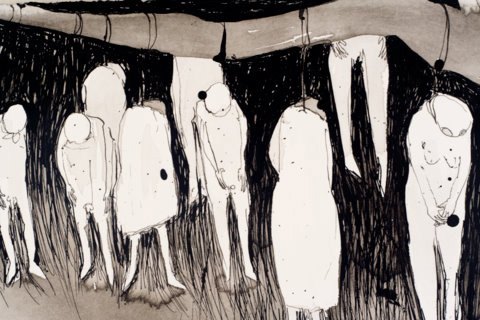
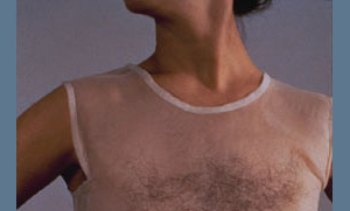
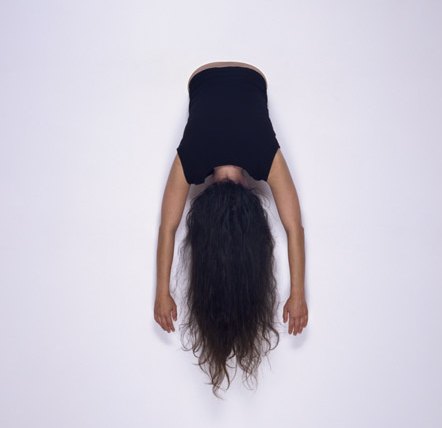

Recent Comments